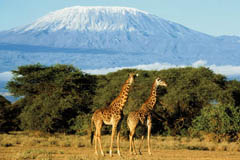 |
Nancy's Travel Journal - Africa
September - October 2005
We began our trip with a 3-day stopover in Amsterdam, then flew to Kenya, where we spent three days in the Masai Mara National Park. We crossed the border into Tanzania and went to Serengeti, Ngorongoro, Tanangire and Arusha National Parks. We then spent 6 days climbing Mt. Kilimanjaro (Rongai Route) and, finally 3 days in Zanzibar. Safari and Kilimanjaro trek arrangements were made by Good Earth Tours. |
You can view the videos of our Kilimanjaro Trek and Safari : These are small (240 pixels by 160 pixels), low resolution versions of the DVDs. If you are on a cable or DSL Internet connection, the movies will start automatically. Do not try to view the movies online if you are on a dial-up line; they will not play properly. The movies require software that will play a WMV file, like Windows Media Player. Click to view:
Kilimanjaro Trek Video
Safari Video
9.23.2005 Friday (Amsterdam)
The first stop on our way to Africa was Amsterdam. The four of us—Steve, Daira, Bill and I—arrived in Amsterdam after our flight from San Diego via Detroit. Felt pretty good, considering the long flight. Took a taxi to our apartment in Amsterdam’s Jordaan District. The apartment was once a butcher shop in the 17-18th century. The meat hooks are still in the ceiling and the bathroom looks like a regular slaughterhouse. Other than that, the place isn’t all that bad, in fact a real bargain at $400 for 3 nights for 2 couples. The Jordaan is a wonderful neighborhood, with old Dutch houses, lots of canals and boats and bicycles.
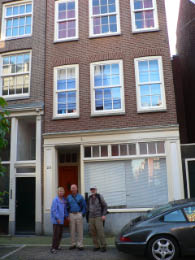
Our Apartment in Amsterdam
|
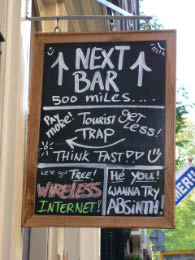
The Funky Jordaan |
After settling into our apartment, we hit the streets at about 2:00pm. We walked to the main square. Went to the Anne Frank house, where Anne, her sister, Margot, her parents, and another family, hid from the Nazi’s for two years beginning in July 1942. Anne was 13. Anne’s father was the only one to survive. It was powerful to see the revolving bookcase that covered the passageway where they hid, and the movie-star poster that Anne has pasted to the wall. Both Anne and Margot died of typhus in Bergen-Belsen concentration camp.
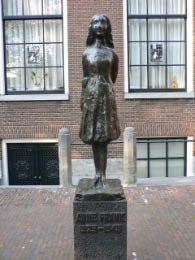
Statue of Anne Frank |
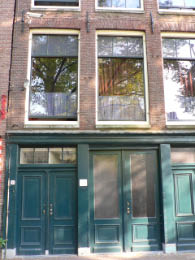
Anne Frank House |
Anne Frank--Some History
Anne Frank was born in Frankfurt Maine, Germany on June 12, 1929. Her sister, Margot was three years older. In 1933 Anne, Margot, her father (Otto Frank) and her mother (Edith Frank) moved to Amsterdam. On Anne's thirteenth birthday she received a diary, she named it "Kitty" which she liked the best out of all her presents. She loved to write in "Kitty." |
 |
By her thirteenth birthday Nazis were taking over Amsterdam and making anti-Jewish rules, and she was Jewish! She hated these rules. She went to a Montessori school. Then because of the anti-Jewish laws, she moved to a Jewish Lyceum where she quickly started to adjust. Then when World War II started her father, Otto Frank and some other clients where he worked created a hiding place in an annex to the office. The family moved into the hiding place as soon as possible.
One day in August 1944, a little after two years of hiding, the Frank family was found and put into a concentration camp. Anne died in Bergen-Belsen concentration camp of typhus as did her sister Margot. Her mother died of starvation and her father was the only one of that family who survived.
Anne Frank is remembered in many ways. There have been books written about her, and plays and movies to tell her story. While she was hiding she kept her diary because she wanted to be educated. Her father Otto kept her diary and two years after she died, in 1947, her father published it unchanged. In 1959, a movie was filmed about her diary. In her short life she was wrote short stories and some short fables. She is remembered most for her diary, published in over 30 languages. Many children all over America read the "Diary of Anne Frank" in school.
Some interesting facts about Anne Frank are, her full name is Annelies Marie Frank, she called her diary Kitty, her father was one of the few people who survived and escaped the concentration camp and made a book about her diary. Anne Frank never got married. She died too young, at fifteen years of age. |
Bought some yogurt and granola for breakfast, the stopped for a beer at a neighborhood bar.
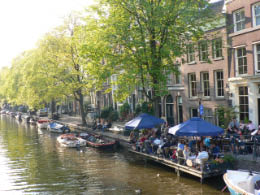
Amsterdam Canal |
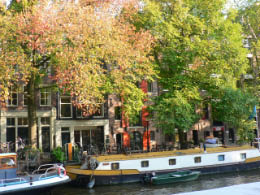
Houseboat on the Canal |
Walked to Koevort, a restaurant in the Jordaan District recommended by Paul, the owner of our apartment. It was charming, quaint and the food was delicious. We all had the veal (that looked like a huge steak) with watercress pesto and pine nuts. The leek soup was so special we asked the chef/owner for the recipe. Turns out the the chef had made up the recipe that day to use up the ingredient she had left over from the day before.
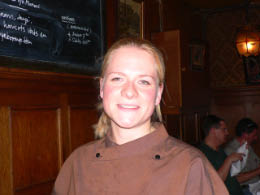
Chef/Owner of Koevort Restaurant |
Daira kept falling asleep during dinner. The sugar rush from her ice cream had worn off. I felt sorry for her with those big eyes rolling up. I faired rather well—very little jet lag—went home, showered and jumped into bed.
9. 24.05 Saturday (Amsterdam)
Made breakfast. Daira discovered last night that all the clothes in her suitcase were soaked. (Her suitcase must have been left out in the thunderstorm when we changed planes in Detroit.) She had to unpack and hang everything up to dry. We walked over to a nearby market, the had coffee at a café by a church. Daira guided us on a Rick Steves walking tour. We walked to Dam Square in the center of Amsterdam, site of the Royal Palace.
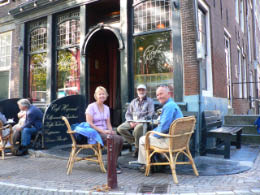
Morning Coffee |
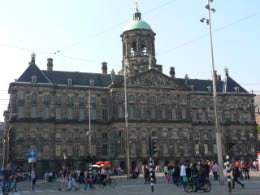
Royal Palace on Dam Square |
Had lunch near the flower market (soup and sandwiches). We then went to the Rijksmuseum, the largest museum in the Netherlands. It was being renovated, but one area was open where they had put all the most famous pieces. There were lots of Rembrandts. We learned about the golden age of Dutch when they ruled the seas and colonies of Indonesia.
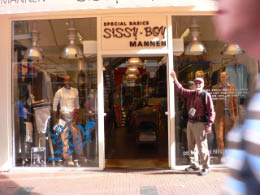
Morning Coffee |
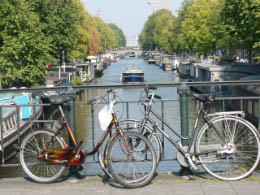
Bikes Everywhere |
Next stop was the Van Gogh museum, which has over 200 Van Gogh paintings (all painted in a 5-year period).
Vincent Van Gogh --Some History
Vincent van Gogh was a Dutch Post-Impressionist. His paintings and drawings include some of the world's best known, most popular and most expensive pieces. The fact that he cut off his ear is very well known, as is the belief that he was driven to an early suicide by lack of recognition of his genius. Here reality and myth are intertwined, and although he certainly suffered from recurrent bouts of mental illness, his suicide was preceded by growing praise for his work from radical critics and fellow avant-garde artists—something which paradoxically caused the painter |
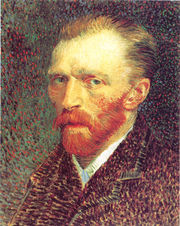 |
considerable anguish.
Van Gogh spent his early life as an art dealer, teacher and preacher in England, Holland and Belgium. His period as an artist began in 1880 and lasted for a decade, initially with work in somber colors, until an encounter in Paris with Impressionism and Neo-Impressionism accelerated his artistic development.
He produced all of his work, some 900 paintings and 1100 drawings, during the last ten years of his life. Most of his best-known work was produced in the final two years of his life, and in the two months before his death he painted 90 pictures. Following his death, his fame grew slowly, helped by the devoted promotion of it by his widowed sister-in-law.
Largely self-taught, his work was startlingly innovative from the very beginning. Neither his early realist work, though close to the Dutch tradition, nor his later impressionist phase met contemporary expectations. His depictions of everyday life showed a highly personal use of media, marked by a bold and distorted style, and visible dotted or dashed brush marks, sometimes in swirling or wave-like patterns, which are intensely yet subtly colored. Since his death in 1890, van Gogh has been acknowledged as a pioneer of what came to be known as Expressionism and has had an enormous influence on 20th century art.
The central figure in Vincent van Gogh's life was his brother Theo, an art dealer, who continually and selflessly provided financial support. Their lifelong friendship is documented in numerous letters they exchanged from August 1872 until Van Gogh’s death in 1890 |
|
We had dinner at Toscanini Restaurant in the Jordaan. Bill and I shared a wonderful swordfish and pasta dinner. I ate more than my share. Our table was near the kitchen so we could watch the cooks work like crazy.
After dinner we took a trolley to the Red Light District. It was Saturday night and the place was hopping. Beautiful prostitutes behind shop windows, in their day-glow bikinis. There were lots of young—and not-so-young—shoppers, and many tour groups just enjoying the experience.
Returned to our apartment at about 12:30.
9. 25.05 Sunday (Amsterdam)
After breakfast we took a train to Haarlem, a quaint little town, a 15-minute train ride from Amsterdam. Turns out there was a hugh 10K race so the town wasn’t so quiet. Stopped for coffee and walked around to see the sites, including the St. Bavo Cathedral.
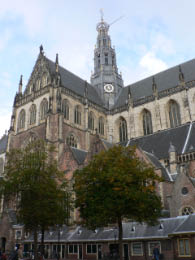
St. Bavo Cathedral |
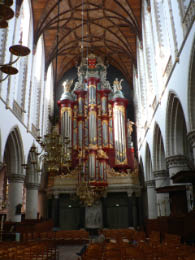
Interior, St. Bavo Cathedral |
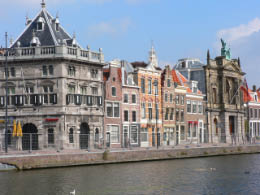
Haarlem |
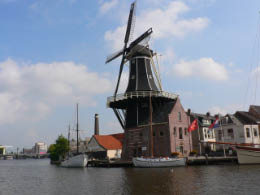
Haarlem Windmill |
Back in Amsterdam, we took a trolley to the Heineken Brewery (it’s actually not a brewery any more—they call it the “Heineken Experience.” It was pretty loud and not that interesting.
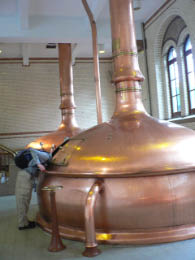
Bill Inspecting the Beer Vats |
Went back to our apartment to rest and pack for our flight tomorrow to Nairobi. Found another excellent restaurant in our neighborhood, recommended by Rick Steves. Great pasta, mussels, stuffed zucchini. Went back to our apartment to get to bed early.
9.26.05 – Monday (Amsterdam to Nairobi)
At 8 o’clock in the morning, the cab picked Steve, Daira, Bill and me up at the little apartment we had been sharing in Amsterdam. We spent 3 days hanging out in Amsterdam and having a grand old time. Now it was time to start our African adventure.
Our flight left Amsterdam at 10:45 am. We spent 8 hours in the air, eating and watching stupid movies.
We landed in Nairobi. Lobo met us at the airport and we waited for Bob and Mad’s flight to arrive from Paris. Lobo was our guide and kept a close eye out as we crossed the parking lot to find our van. We drove to a Holiday Inn on the outskirts of Nairobi – very nice, peaceful place tucked behind high walls and iron gates.
9.27.05 – Tuesday (Nairobi to Masai Mara Park – Sarova Mara Camp)
We ate breakfast then meet Titus, our driver and guide for Kenya. We got to know Titus pretty well over the next three days. He was a sweet, loveable man, quiet and confident. He has 4 kids, ages 5 to 20. We could tell he was the elder statesman among the guides. He always had a smile on his face and was always joking with his buddies. Tito means girl – another source for Titus jokes among the gang.
Only 20 minutes out of Nairobi and we had a flat tire.
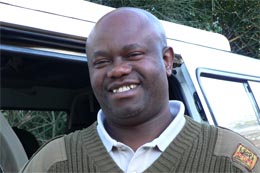
Titus, our guide in Kenya
|
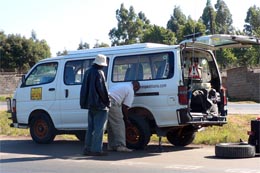
Flat tire only 20 minutes out of Nairobi
|
Titus quickly changed the tire and got us back on the road. The sites got more and more interesting and exotic as we drove through the Great Rift Valley to Masai Mara National Park.
The tall acacia trees dotted the landscape. The road got rougher and the dust thicker. A few mini buses filled with tourists flew past us.
The people and scenery were from another world -- colorful markets, women carrying babies on their backs, people with their heads piled high with all manner of stuff, goat and cattle herders. We were especially fascinated with the Masai Warriors -- guys dressed in bright red tablecloth-togas with spears and walking sticks, most of them with their precious commodity -- a herd of cattle.
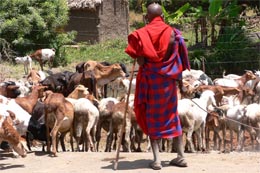
Masai Goat Herder |
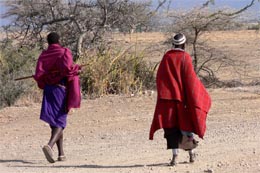
Masai along the road |
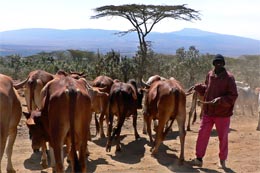
Roadside cattle herder |
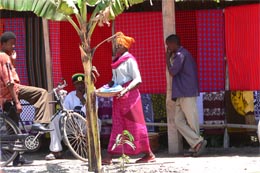
Cloth store |
As we drove into the plains, we spotted wild animals. My first sighting was three baboons crossing the road – couldn’t believe you had to watch out for baboon crossings. (Later, as the trip worn on, we saw so many animals that we became jaded and grew to expect them as part of the landscape.)
We arrived at the Sarova Mara Tent camp at about 2:00 and enjoyed a beer along with some mighty good food – buffet style. What a beautiful place -- a fancy lodge, cozy elegant single tents, beautiful grounds and a wonderful, inviting swimming pool (which we didn’t have time to enjoy).
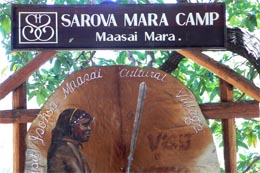
Sarova Mara Camp Lobby |
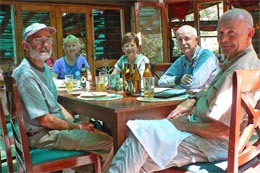
Sarova Camp Dining Room |
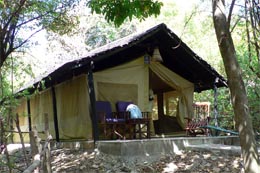
Our "room" at Sarova Camp |
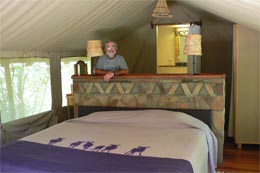
Our bedroom |
Titus picked us up at 4 that afternoon for our first game drive. We were all so excited and screaming about everything we saw – zebras, giraffes, gazelles, elephants, Okapis and a huge herd of wildebeest.
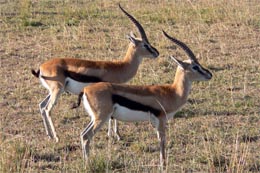
Thompson Gazelle |
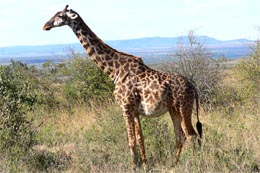
Our first giraffe |
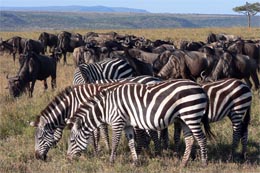
Zebra and wildebeeste |
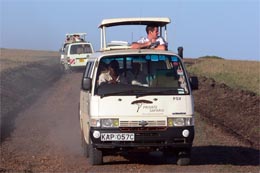
Safari Van |
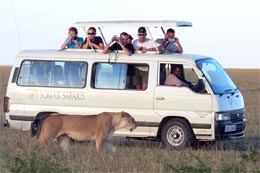
Lioness in Masai Mara |

Lion watching Titus fix tire |
The highlight of the evening was another tire blow out right by a group of lazy lions. The lions came to life and surround Titus when he first opened the door. Then Titus radioed to other vans to surround us while he got out and changed the tire. (It must have been a day for flat tires and now not a spare left.)
On the way back to the lodge, Titus stopped the van so we could take wonderful sunset pictures.
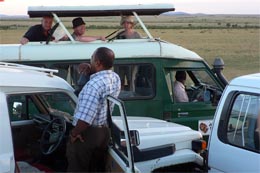
Vans provide protection |
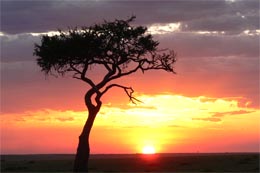
Sunset in Masai Mara |
Back at the lodge, we consumed large quantities of lamb chops. At 9:15 pm in the lobby, dancers from a nearby Masai village put on quite a show. They chanted and jumped so high with their eyes rolled up in their heads. Several had shoes with tire treads. Africa is pure magic.
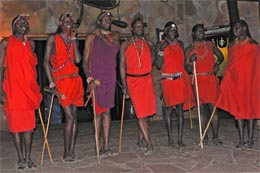
Masai dancers at lodge |
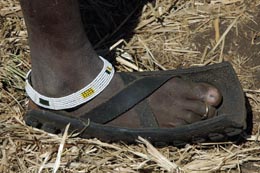
Masai Shoe |
9.28.05 – Wednesday (Sarova Mara Camp) to Mara Simba Camp
We started the day with a 6:30 am game drive in Masai Mara National Park. It was a delight to see the animals in the early morning light.
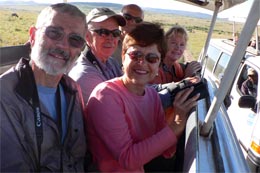
Gang in the Safari van |
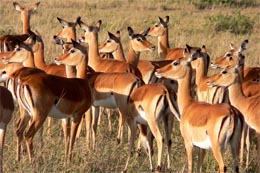
Impalas |

Cheetah |
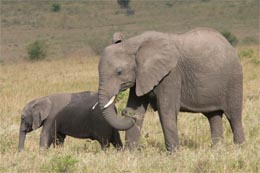
Mom and baby |
We returned to the lodge for an excellent breakfast. At 10:30, we drove to a nearby Masai Village. Tom, the son of the Masai chief, was our guide to his little village. He is 20 years old, a doctor and teacher and very articulate. He studies in Nairobi and returns to the tribe to teach and help his people. He collected a $20 fee from each of us with a very big smile on his face.
The program started when some 15 or more spear-chucking warriors began running, chanting and doing their jumping routine in the open field. I had a great time bonding with my new warrior friends.

Tom, our Masai village guide |
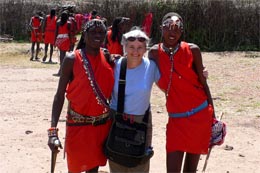
Nancy's Masai friends |
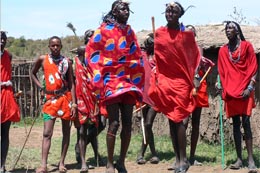
Masai jumping |
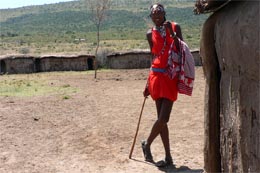
Masai next to his hut |
Next, we entered the little village of round huts and watched the women and children play and sing. It was tough seeing flies everywhere, especially on the children. Because the cattle sleep in the center of the huts at night, they bring flies and disease to the tribe. Many Masai suffer from eye infections called appropriately “cattle disease.”
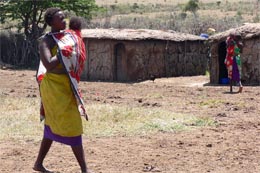
Masai mom and baby |
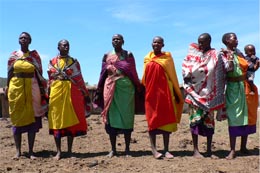
Masai women chanting |
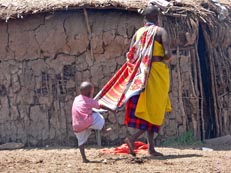
Masai kid in tow |
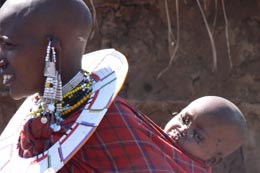
Check out those earrings |
About 95 people live in Tom’s village. The women build the huts. It takes them about one month to construct a hut. Tom took us into a hut – chickens, and other animals are in the tiny entrance room while nine people sleep and eat in the other room. The place was smoky and smelled of urine. It was dark – not a cheery place to call home.
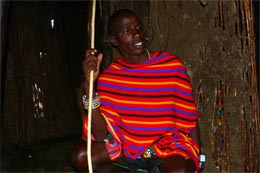
Tom inside hut |
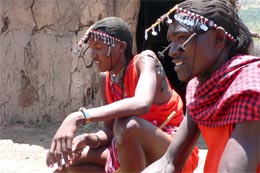
Handsome Masai guys |
Tom told us about his people. Here are some of the facts that I remember:
--They use Cyprus and Acacia trees to make medicine for malaria.
--They make their own birth control.
--They have a maximum of 6 kids mainly because they are very concerned about the cost of educating their children.
--Education is a high priority in this poor country.
--Each male must kill a lion to get circumcised and kill another lion to have the right to marry.
--Now the Masais limit themselves to only two wives
The Masais drink milk and blood from their adored cows. The herders use a flask to catch the blood. Their diet also consists of occasional hunk of meat – but rarely from their precious cows.
Two young Masai Warriors demonstrated how they make fire. These guys had a fire going in less than 30 – very impressive. They used soft wood from the acacia tree and hard wood from a Cyprus tree and rubbed the sticks together. Their long fingers were flying. The sparks fell on some dried moss from a tree and the fire started immediately. After they learn how to start fires, they earn the right to take the hot sticks and burn their arms. They are very proud of their scars. We laughed and mimicked, “Ouch, that hurts.”
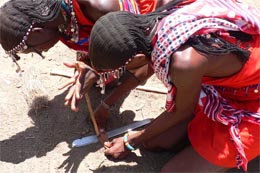
Masai starting fire |
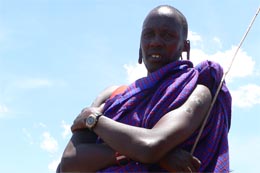
Masai with scar on his arm |
After the Tom’s tour, we went to the Masai “Supermarket” to buy souvenirs. Bill and I got a lot of stuff for $75 – wood carvings, beaded jewelry, and a lion tooth necklace for Brian. Bill loved negotiating with a tribe of fearless warriors and didn’t back down – but we think they got the best of us. They have no prices posted – everything is negotiable.
We went back to Sorova Lodge for lunch and then gathered our bags and moved 10 miles down the road to Mara Simba Lodge.
Bill and I had an isolated tent way at the back of the property – Tent #8. One of the guards at the lodge took us on a tour to see hippos in the river. We followed down a little path and climbed through a barbed wire fence. I loved being off the beaten path where hippos and crocodiles hang out at the local watering holes.
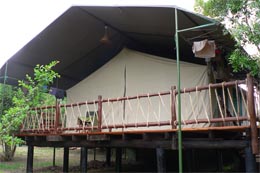
Our tent at Mira Simba Lodge |
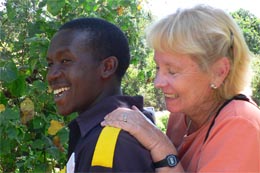
Daira, what are you doing? |
After our hippo and crocodiles encounter, we took an afternoon game drive.
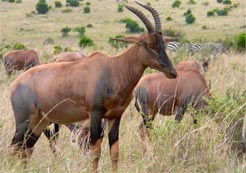
Topi |

Wildebeeste |
The highlight was two lions mating. The male and female lion isolate themselves and hang out for one week, sleeping and mating about every half hour. We watched these two go at it twice – same routine. The male looked proud and the female looked bored. A herd of us “vans” watched every move, making crude comments.
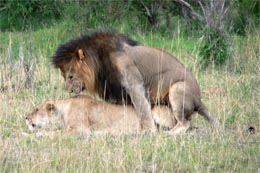
Lions mating |
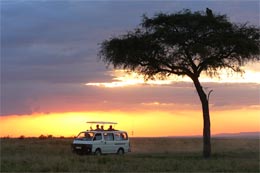
Sunset |
We returned to the Simba Lodge to stuff ourselves with another huge dinner buffet. That night, right outside our tent, we heard the hippo grazing and then we heard the wind blowing through our tent – what a grand experience!
9.29.05 –Mara Simba Camp
Up early for the game drive and then back for a huge big breakfast. Life is very good.
We loved our routine of a morning game drive before breakfast and an afternoon game drive before dinner. We have seen so many amazing animals in the Masai Mara National Park and taken so many photos.
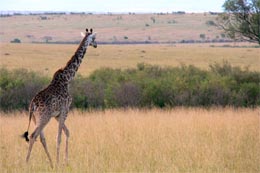
Giraffe on plains |

Hyena |
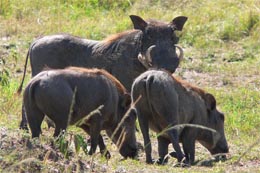
Warthogs |
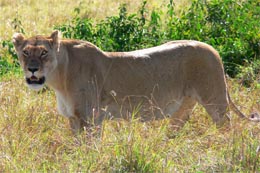
Lion in Masai Mara |
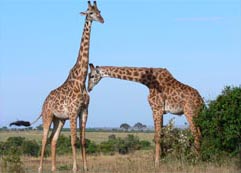
Giraffes necking |
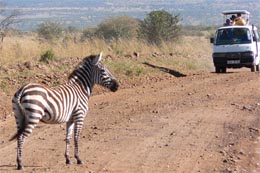
Zebra |
The staff at the Simba camp are wonderful. Able, our waiter, wears beautiful white shirts with a tie and a most beautiful smile. He has 5 kids. He told us his vasectomy didn’t work. Every night he told us about how he must educate and provide for his kids. His children are 18, 16, 17 and 8. He worries about them passing their exams. It’s a hard life for him and he misses his family very much. He works three months and then goes home for two weeks.
At dinner, Daira, a little tipsy from her vodka and crystal ice drink, asked Able about his own personal circumcision rights. Able was so open and cool. It’s an important rite of passage for African men. Right after the circumcision, he and his newly circumcised pals had a big 30-day party in the jungle to celebrate.
I also adored the manager of this place – De Marisa Luki. She was the big, cool Lodge lady at the front desk who tries to be stress-proof. She is wonderful, warm and gives the best hugs ever. She has four children – youngest is 4 and the oldest is 20.
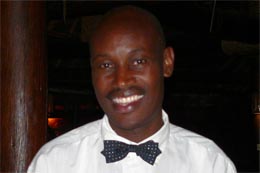
Able, our waiter at Mara Simba Camp |
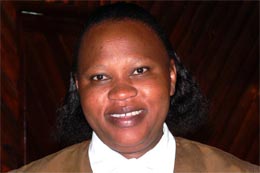
De Marisa Luki, Hotel Manager |
The lodge workers ride the bus or van to work. They work for two or three months and then return home. Such sweet, hardworking people.
This was indeed one special place. I loved the river that flows by the lodge. There is always something going on – crocodiles, hippos, storks, exotic birds and even a couple of mongooses.
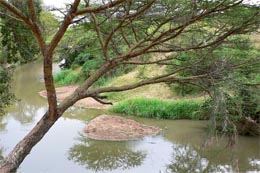
River next to Mara Simba |
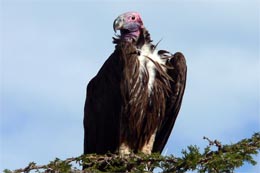
Buzzard |
9.30.05 – Day from Hell – Drive to Tanzania – Serengeti National Park (Ikoma Bush Camp)
After breakfast, we said our good-byes to our new friends at the lodge. We were sad to leave Masai Mara National Park and Titus, our guide. We also dreaded the 10-hour trip ahead over bumpy, dusty roads.
We left at 7 in the morning and drove to the Tanzania border crossing (Sirari) and then exchanged Titus (our Kenya guide) for Elis (our Tanzanian guide).
The border crossing was easy – lots of activity and signs that said, “Don’t take bribes.”
From our van, we saw so much life passing by. This time the views were not of animals, but people walking along the roads with their herds, or balancing huge items on their heads, or riding old bicycles.
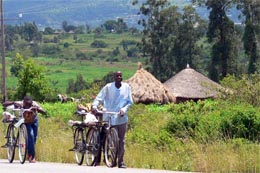
Roadside Bikes |
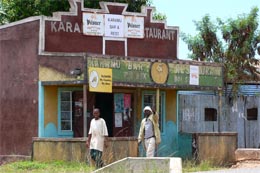
View from the van |
Masai are easy to spot in their bright red cloths herding goats or cattle all over the landscape. I saw a group of warriors resting under a tree by the side of the road. I stuck my camera out the window to get a photo and one lifted his spear at me, posed to aim it at me. It made me laugh and I quickly put the camera down.
Elis, our new guide, is a very quiet, sweet, smart guy – 29 years old, one wife who works as a cook. They have a two-year-old son. Elis’ sister is in Seattle, sponsored by a family to get her education. She is studying computer science.
Elis was a very knowledgeable guide. He knew the names of the animals, birds and plants and shared his book with us. He especially loved the birds. I’m amazed at how quickly he could spot critters from miles away. He said Good Earth was a great company because during the off-season, they send their employees to school to learn more. Good Earth drivers / guides are very happy campers – which makes their customers extremely happy campers!
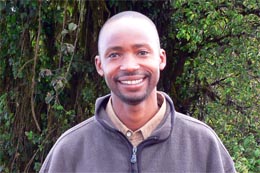
Elis, our guide in Tanzania |
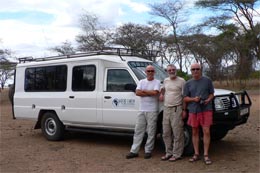
The guys with the Good Earth Safari Van |
We stopped off the road near a little village. Elis parked our van and we ate our lunches. It was a huge lunch. Little kids came up to the van begging for food. They were wearing rags that we wouldn’t even use for dusting. These scenes would break your heart.
We had a bathroom stop at the Serengeti National Park gate. The place was loaded with Vervet monkeys. One tried to get into a car. Very clever guys. (I’ve stopped taking as many pictures – I’m running out of memory – HELP!)
We were also amazed at all the baboons. I saw so many baboons along the road for miles and miles, each one about 10 feet apart from each other – traveling together in big herds. I wanted to stop, but we still had a long journey to our camp.
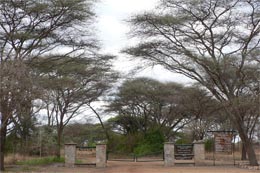
Serengeti National Park |
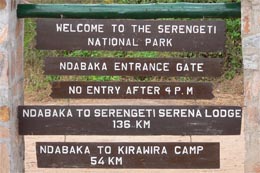
Noabaka Entrance Gate |

Baboon |
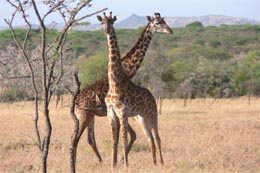
Giraffes by acacia tree |
At about 6:30 pm, we finally arrived at Ikoma Bush Camp – the coolest, “real-est” place yet. The Bush camp only had a total of about 13 tents to book and was located in a very remote area. The friendly staff greeted us like we were old friends.
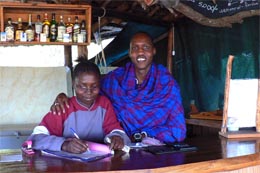
Ikoma Bush Camp Staff |
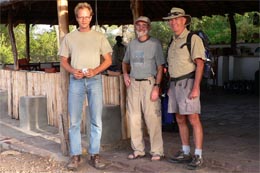
Bill and Steve with the manager |
The managers of the camp were interesting. They were a young German couple on holiday when their car broke down in Africa. His parents had booked a flight to meet them in Arusha. The parents’ trip was delayed because his father got sick – so the young German couple had to settle down and get a job.
They first worked as guides in Arusha National Park and now they manage this cool bush camp in Serengeti. They went from 9 employees to 48. They bring all sorts of people from different tribes and train them. They seemed to have a fun, relaxed relationship with their employees. They live with the employees in a compound tucked just behind the main lodge. That place was a mess. I went back to the employee compound to charge our batteries and a got a peek.
The German couple is also building a house in Arusha. They hired two folks to watch it 24 hours a day and also hired a gardener. The German guy loves it here on the Serengeti. He has no office, no commute, and no rat race. His girlfriend adores the warthogs. Meeting the people in Africa is just as interesting as observing the animals.
We loved our sleeping quarters. I could just see Hemingway writing at the desk on our front porch. Our tent was facing the wild Serengeti in the most brilliant sunset I’ve ever seen.
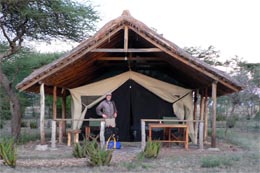
Bill at our tent at Ikoma Bush Camp |
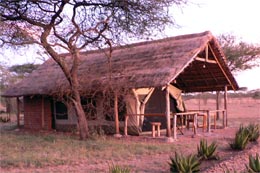
Our tent at sunset |
After a dinner of beef (or pork chops) served by courses (not buffet lines), we went out side and sat by the fire and listened to amazing stories.
The only other people at the camp that night were a proper (and wealthy, I’m sure) family, on holiday. They live in Tanangire and run a coffee farm. The father, mother and two children were so sophisticated. The father’s family lived in Africa since 1927. He described how the National Park Service is slaughtering elephants. He heard two shots on his property and then viewed men in park ranger uniforms picking other elephants off like in “someone in a shooting gallery” – as he described it.
He told us about all the changes he had witnessed in Africa – from colonial rule to dictators to a non-existent infrastructures and have to go across the border to smuggle back toilet paper. This beautiful, dignified family was straight out of a novel.
The main star of the evening campfire was the Masai Warrior who came to take our drink order. I encouraged him to tell us stories about life as a warrior and we got a whole evening of wonderful tales from the bush.
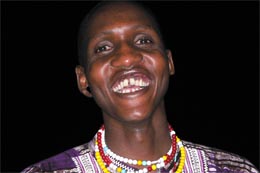
Bar tending Masai Warrior |
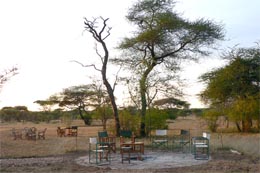
Outdoor bar at Ikoma Bush Camp |
Stories from the Warrior:
Our warrior has 98 cows – His brother watches the cows while he’s working. He misses his cows. (Bill asked if he missed any one cow in particular.)
He has one wife and one son. He wants more wives because he has a lot of cows. His parents “booked” (a term he used) his wife. Some wives are booked before they are even born. He said his wife cried when she saw him – didn’t know exactly if it was tears of sadness or joy.
Husbands and wives usually come from different villages. They have a tradition of giving gifts equivalent to steps taken to get to the husbands village – e.g., 1 cow = 2 steps; 1 goat = 1 step, 1 child (slave) = ½ steps, etc. to get her approximately 1 kilometer to her husband’s village.
Our storyteller said he killed two lions and is now a Masai Warrior. He practiced lion hunting on smaller, but dangerous animals, such as a porcupine. He told the story of trying to kill a jackal, but he missed and killed his dog. He was so angry that he eventually killed the jackal for revenge. He misses his dog, but not his wife.
Warriors are designated only in seven-year periods. There is no circumcision for seven years. Those that kill a lion are initiated (and circumcised) all at once. The boys all recover and party for one month together (just like Able, the waiter reported). The young warriors wear their hair long the first seven years. The second seven years, they cut it off. After 14 years of warrior-hood, they get to retire and have the village take care of them.
Our campfire warrior said he loves California, but Colorado is his favorite state because it has more cows.
Masai steal cows from other tribes because they’re really Masai cows in the first place.
There are laws against killing lions, but if a Masai kills a lion and gets caught, he can easily claim the lion was killing their cows. All they have to do is get some old cowhide to prove it – not a problem according to our Masai friend.
Masai are from the Sudan. They are famous walkers and herders. They use the stars to guide them at night. They know the exact time of travel and where to find friends. (They don’t need no stinking GPS.)
Masai rub medicine on their bodies to repel lions. They live to be 100. When one dies, the whole village moves. (I find this fact difficult to believe.) According to Elis, men are lazy like lions while women build the houses, make the food, and take care of the kids. So much to learn about this strange and fascinating place.
10.1.05 –Serengeti National Park (Ikoma Bush Camp) to Ngorongoro Farm
We were up early to witness a beautiful sunrise on the Serengeti. After breakfast, we left promptly at 7. We were sad to leave this magical place. We had a long day filled with adventures, animals and driving on dusty roads.
First we went on a game drive through the Serengeti.
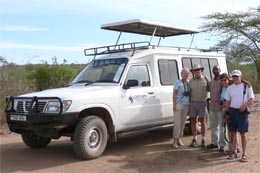
Steve, Daira, Bob, Madeleine and Elis |
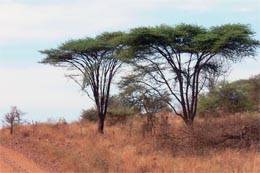
Acacia Trees |
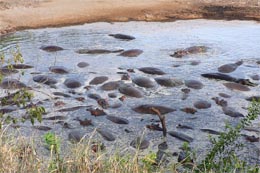
Hippo Pool |
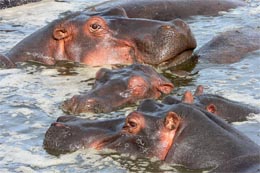
Hippos |
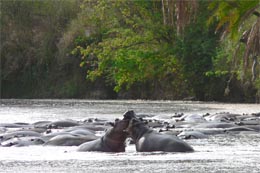
Hippos fighting |
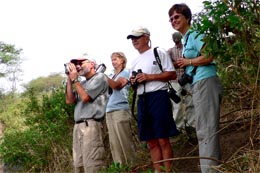
Bill. Daira, Bob and Madeleine |

Crocodile |
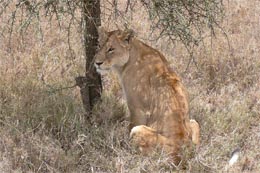
Lion under tree |
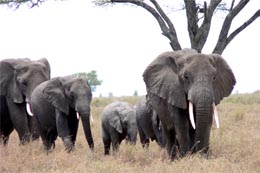
Elephant family |
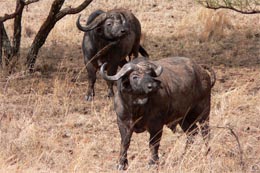
Cape Buffalo |
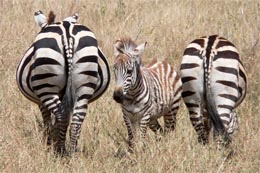
Zebra from behind |
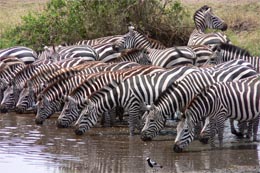
Zebras at watering hole |
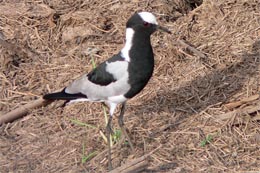
What kind of bird is this? |
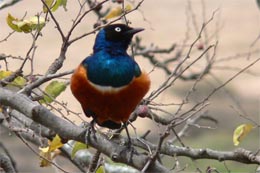
Can you identify this one? |
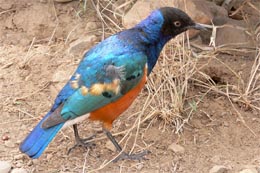
We saw lots of these |
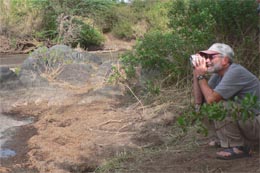
Bill filming hippos |
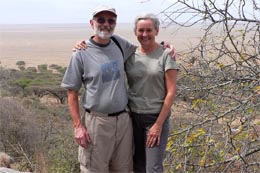
Bill and Nancy |
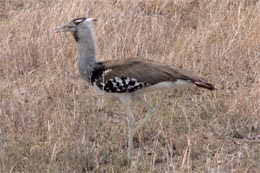
Kori Bustard |
At 3:30 pm, we went to see the Olduvai Gorge, It features the remains of the earliest human beings, who were discovered by Dr. Louis Leakey and Mary Leakey in the earlier part of the 20th century. Olduvai Gorge is called the Cradle of Mankind - as it is the place where humanity first appeared as a species. The first humans ever to exist, lived their life in Tanzania, specifically, as fossil records show that Olduvai Gorge was one of the earliest inhabited valleys.
The footprints were discover in 1960’s while the scientists and researches were taking a break and having some fun throwing buffalo dung at each other.
The Leaky’s traveled with two Dalmatians and stayed in a truck. The dogs warned them of lions. Dr. Leaky got malaria on his first visit, but stayed to do the work . A guy from the French government, gave us a lecture while we were overlooking the entire gorge – very interesting. I loved the simple little museum – like a peak into someone’s scrapbook.
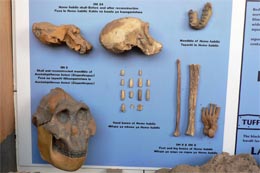
Museum at Olduvai Gorge |
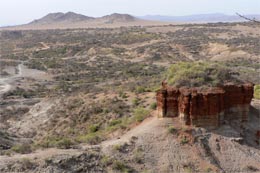
Cradle of Civilization |
At 5 o’clock, we stopped at another Masai Village. Elis said that this one was a REAL Masai village. The people here really lived in the bush and were not dependent upon markets or others for survival. However, the government does deliver water to them in plastic gallon containers (yellow for washing / clear for drinking) on Donkey carts.
The girls -- Daira, Mad and I -- paid $20 each to go into the village. (The guys waited in the van.) Daira loved the children and sharing the digital photos. Mad was overwhelmed and left. I went around snapping photos and soaking it all in. Of course, they all wanted us to buy their jewelry, earrings, etc. We left our money in the van with the guys. We finally left when the battery from Daira’s digital camera ran out of juice. The women and pre-school aged children hang out mostly inside the village while the older kids and men roam around outside. One of the old guys and I bonded. Lots of smiling photos.
Poverty is terrible (measured by our standards and the world’s standards for that matter). We saw someone lying on the ground who looked very sick – maybe aids – maybe anything. Kids were everywhere in rags and runny noses. The women were all decked out with loads of jewelry and bright colored clothes. Elis said they go naked when the tourists aren’t around.
At the van, two teens were trying to trade their walking sticks for Bill’s watch – no dice. The guys were glad when we returned. Daira and I could have taken many more photos.
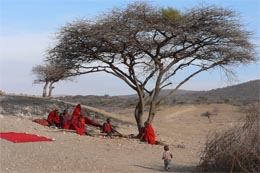
Masai |
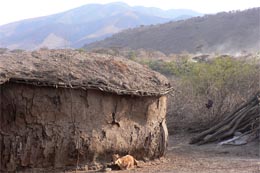
Masai Hut |

Masai by his hut |
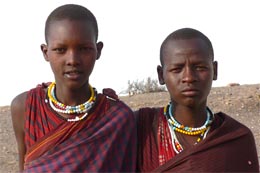
Masai Teenagers |
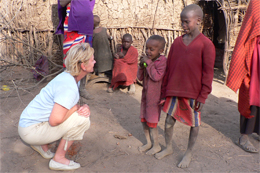
Daira with Masai kids |
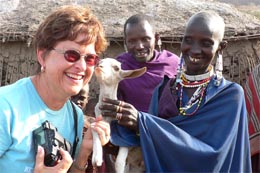
Madeleine with Masai |
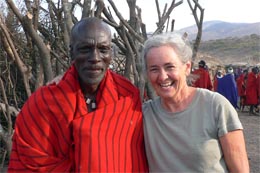
Nancy with Masai Babu |
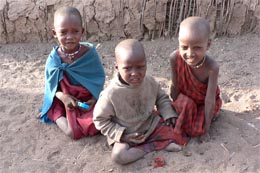
Masai kids |
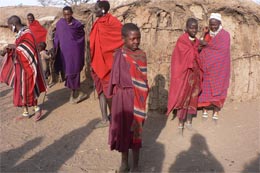
Masai in village |
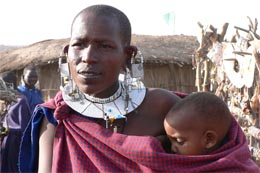
Masai with baby |
We headed to Ngorongoro Farmhouse to spend the night. The road was bumpy and dusty. We caught glimpses of the huge crater on our left (the famous Ngorongoro Crater). Bill complained about another change in accommodations. All Elis said was “It’s a very, very nice place,” and boy was he right!
We finally arrived at the almost amazing paradise – beautiful gardens, simple elegance – wonderful dining room. Then the half-mile walk to our little homes – huge rooms, like an apartment – fireplace, and heavy front doors. Annie, the receptionist with the really cool sculptured hair, said, “NO tipping” – but we couldn’t get rid of the guy until we gave him a buck. I said, “Don’t tell Annie!”
None of us could get over the place. Then a fancy dinner with 5 or 6 people serving us with trays of yummy food – lamb stew, veggies. I felt like we were British back under the colonial rule. We got the chef’s recipe for the wonderful pumpkin soup.
We had a table set for 7 so we made poor Elis join us after being stuck in a van with us all day. He ate very little. When we asked what was wrong, he merely replied, “Masai Warriors don’t need very much.” The rest of us porkers really put the food away. SHAMEFUL. We all are fat and dress like what we think is the proper Safari attire. These guides must think we’re nuts and have way too much money.
After dinner, we went back to a smoky room. The hotel stuff came in earlier to light the fire in our room in order to take the chill off (because of the long walk back from the dining hall.) SHAMEFUL Again. I am feeling so guilty about being a FAT American – but I have to say, life styles of the rich and famous ain’t all that bad.
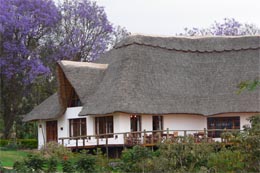
Ngorongoro Farm |
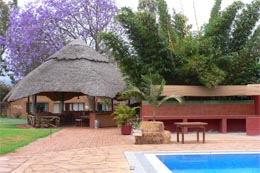
Ngorongoro Farm Pool |
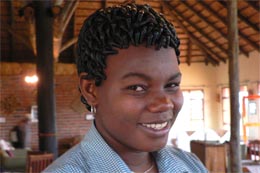
Annie, our waitress |
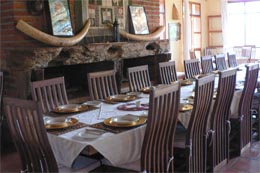
Ngorongoro Farm Dining Room |
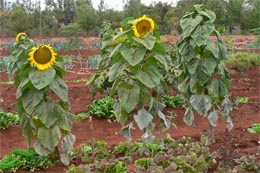
Ngorongoro Farm |
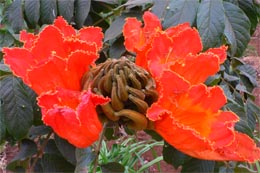
Ngorongoro Farm |
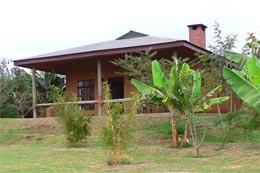
Our room at Ngorongoro Farm |
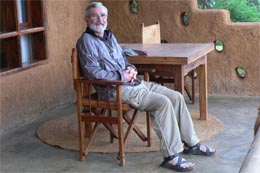
Bill on our porch |
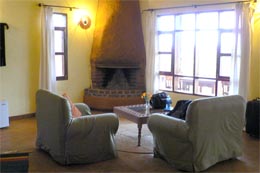
Our Room |
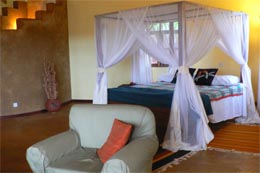
Our Room |
10.2.05 – Ngorongoro Farm House to Ngorongoro Sopa
Up early for a wonderful breakfast. Daira and I became pals with the chef. He thought it was funny that we added whole tomato slices to our omelets. The food was very fine. Hate to leave.
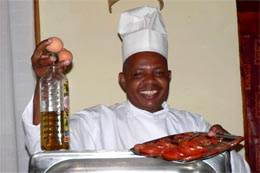
Making omlettes |
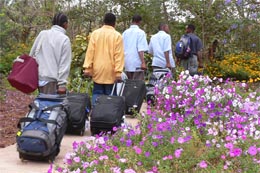
Porters at Ngorongoro Farm |
This was our day to do the Ngorongoro Crater. It seemed like hours of driving inside of an amazing geological bowl – but with no exciting animal spottings – maybe we’re jaded now. Elis told us that 50,000 animals live in the Ngorongoro Crater year round and 20,000 migrate in and out. Most of the animals on that day were tucked away or far from the road – but I still managed a few good photos as illustrated below.
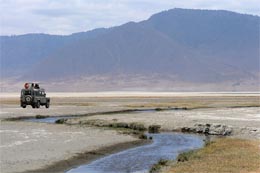
In Ngorongoro Crater |
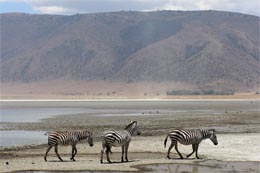
Zebras at watering hole |
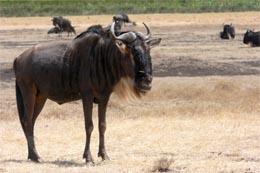
Wildebeeste |
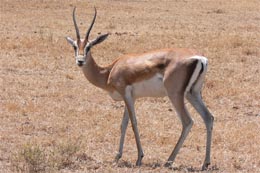
Grant's Gazelle |
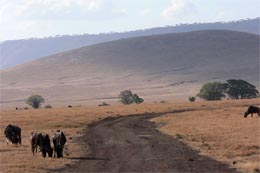
Road through Crater |

Lion under tree |
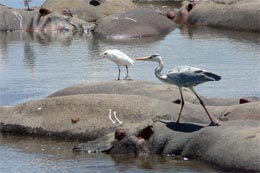
Birds on Hippos |
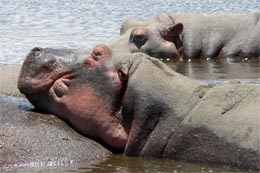
Hippo resting |

Male ostrich |
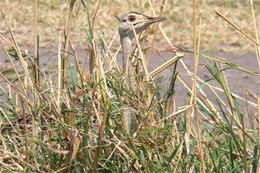
Bird in the bush |
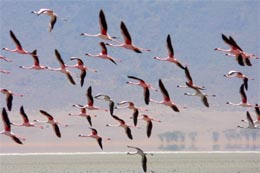
Lessor Flamingos |

Cape Buffalo |
We ate lunch at a huge parking lot filled with vans. We couldn’t get out of the vans because of the huge kites (birds) that swoop down and grab your food. After we were finished eating, we got out and walked down by a lake and a tree. There were long lines for the bathrooms. Everyone was complaining about the toilets that don’t flush, dirty hands, etc…. Mad and Daira talked with a woman in line who was on a game hunt and was bragging about shooting zebras – Disgusting.
It was a long dusty ride up out of the crater on the way to our lodge, but the umbrella trees and the early evening light afforded spectacular views.
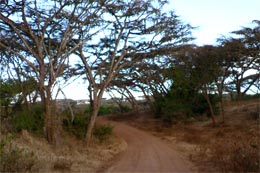
Umbrella Trees |
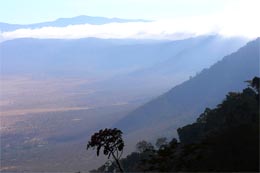
Ngorongoro Crater Overlook |
We stopped at the rim of the crater at an overlook. Elis pointed out all the places we’d seen – Hippo pool, Elephant grass, lunch spot and lots of other stuff.
We arrived at the Sopa Lodge just in time for the sun's last rays to light up the crater with golden tones. The Lodge is perched on the Crater rim in a lovely setting. The bellhops were dressed in brightly colored togas. The main lodge was breathtaking and the individual circular rooms all had great views, but the rooms were a little in need of repair.
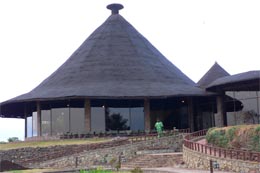
Sopa Lodge at Ngorongoro Crater |
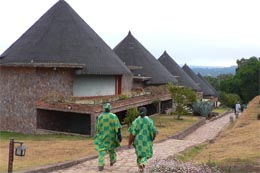
Hotel rooms at Sopa Lodge |
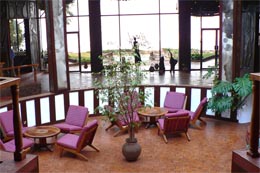
Sopa Lodge Lobby |
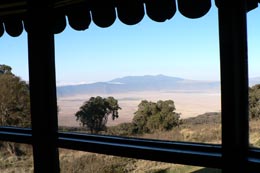
View from our room |
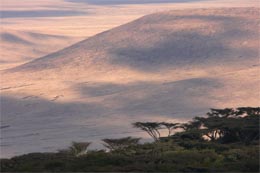
Crater overlook, Sopa Lodge |
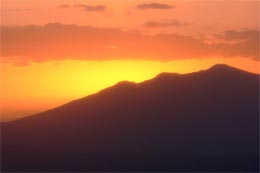
Sunset at Ngorongoro Crater |
We had a fun dinner with our new waiter -- Brother Godson. He asked us our names and called us Brother and Sister. Later we learned that he has three sons – ages 9, 7, and 4. We gave him little cars for his boys. He said he misses his family. That story is pretty common among the staff – sure works great for extra tips.
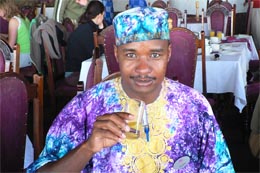
Godson, our waiter at Sopa Lodge |
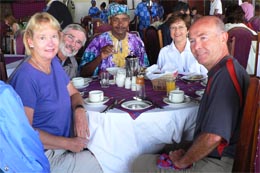
Steve, Daira, Bill, Mad and Godson
|
10.3.05 – Ngorongoro Sopa to Tarangire (and 10/4/05 – Tarangire a second night)
After breakfast, we headed to Tarangire. I loved snapping photos from the window of the van to capture all the life I could. (I honed my “grab a photo fast” skills as we dashed by all sorts of activity.)
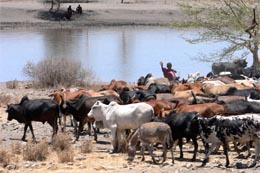
Cattle herder |
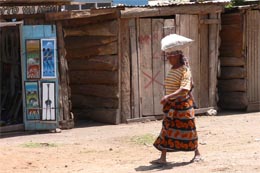
On the drive to Tarangire |
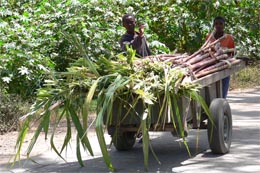
Scene from road |
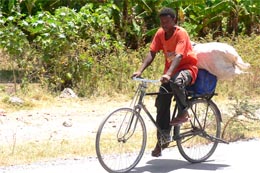
Guy on bike
|
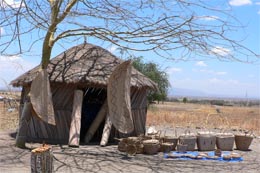
Hut with baskets |
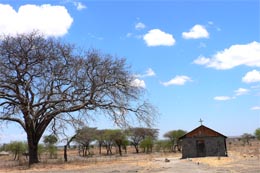
Lonely Church |
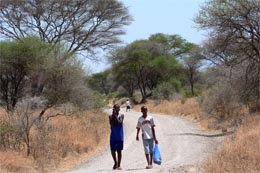
Two boys on road |
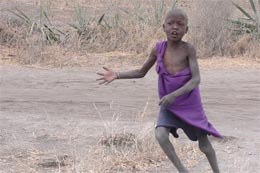
Boy chasing us for a handout |
En route to the Tarangire Safari Lodge, we rendezvoused with the other members of our group --- Leo, Debbie, Kim, Deb, Sherry, and Al at a dusty souvenir shop by the road. They were on their way to the Ngorongoro Sopa Lodge – the place we had just left. Arrangements were very screwed up – the whole group was supposed to be together by now.
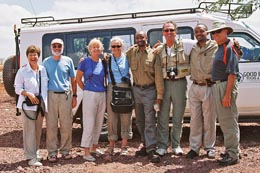
The whole gang at the souvenir shop |
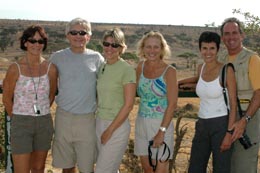
The young studs |
Tarangire Safari Lodge was a very nice place in a wonderful location.
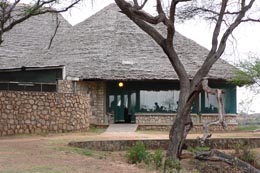
Tarangire Lodge. (Leopard was on wall to the left)
|
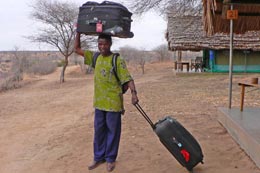
Taking our luggage to our tent |
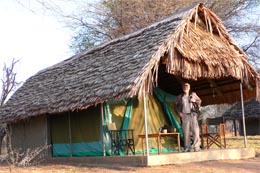
Bill by our tent |
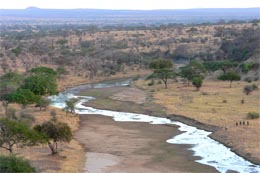
View of river from our tent |
We had two days of wonderful safaris in the Tarangire. Elis was a good guide and shared his world with us. He told us about the Baobab trees – devil trees that are 1,000 years old. Elephants get water and minerals from the bark. Africans are very superstitious and stay far way from a Baobab tree. Poachers aren’t afraid of the tree. They easily stash the elephant tusks into the tree’s trunk or hide themselves. An old African legend tells of God being so angry with the Baobab tree that he pulled it up by its roots and planted it upside down (and the tree does look like roots are growing out of the top.)
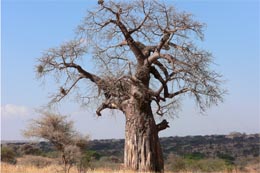
Baobab tree |
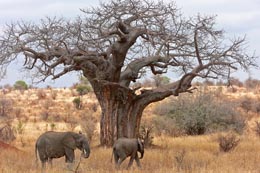
Elephants by Baobab tree |
I was also fascinated by the sausage trees – looked just like sausage hanging off the branches. Baboons eat the sausage. Titus told us some people make beer from the “sausage.”
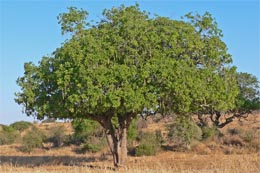
Sausage tree |
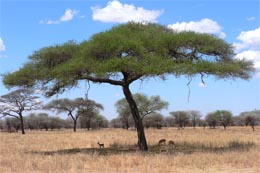
Acacia tree |
Animals need the trees not only for food, but also protection from the hot, midday sun. We saw so many animals huddled together under the shade of a tree.
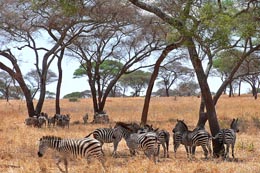
Zebras under trees |
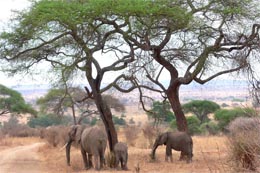
Elephants under trees |
Through the top of our van, we looked up and saw a python in the tree. Daira was really spooked because she’s terrified of snakes. This fellow looked like a big cinnamon bun rolled up in the top of the tree. After it eats, the snake takes a long time to digest it’s prey, so it doesn’t move for about a week. Our python didn’t move for a couple of days – we checked on it and sure enough, hadn’t moved an inch!

Python in tree |
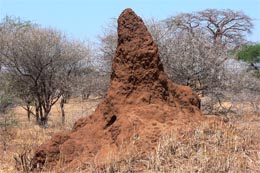
Termite mound |
Elis is gun shy of elephants. He told us that a couple of years ago, an elephant charged his van and jumped up on the roof with his front feet. Luckily the elephant blew out all four tires and that scared the elephant away. We were close to being charged twice. Usually Elis would wait patiently for us to finish taking photos or viewing the game with our field glasses. But, once he didn’t wait, he gunned the engine and flew out of there leaving me, flat on my butt in the middle aisle of the van with a huge scrap on my leg. But I got the photo of that angry elephant, truck up, legs charging!
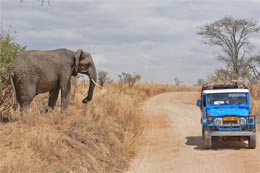
Elephant checking out jeep |
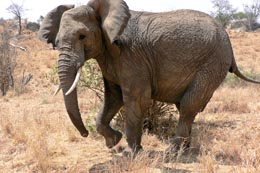
Elephant charging our van |
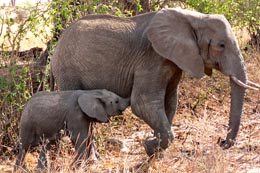
Elephant mom and baby |
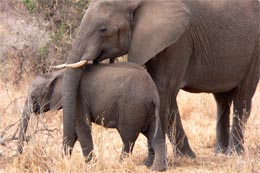
Elephant hug |
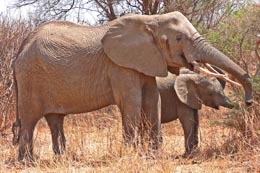
Mom and baby eating |
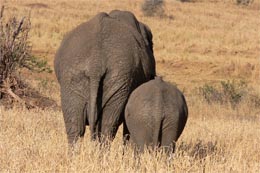
Big butts |
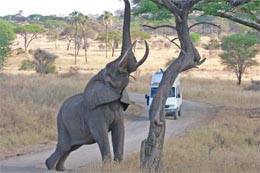
Elephant reaching for food |
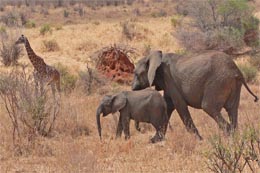
Elephants and giraffe |
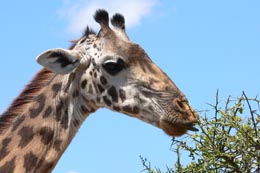
Giraffe eating acacia tree |
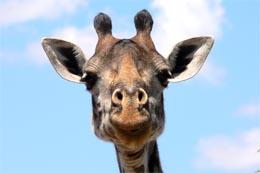
Giraffe |
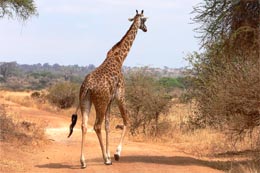
Giraffe crossing road |
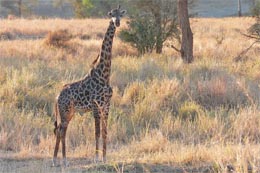
Giraffe checking us out |
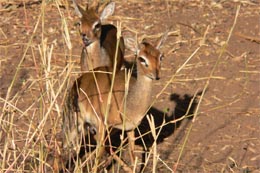
Dik-diks |
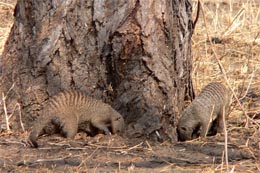
Banded mongoose |
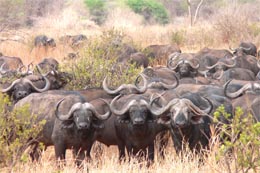
Cape buffalo |
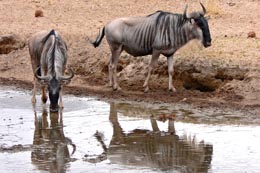
Wildebeeste |
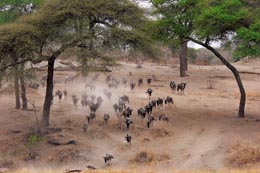
Wildebeeste running to water hole |
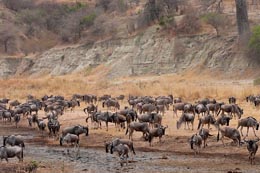
Wildebeeste at water hole |
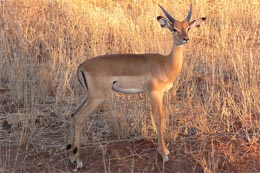
Impala |
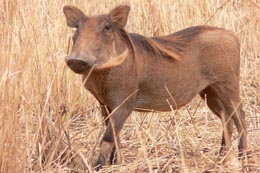
Warthog |
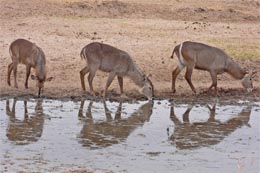
Waterbuck |
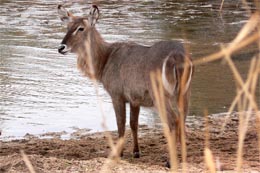
Waterbuck |
During both afternoon game drives, Elis took us to “Baboon World.” They were our favorite animals to watch. They were so much like us. We saw loving parents, sweet babies, fussy ornery babies, bullies, pesky teens, bratty kids, aggressive macho guys, sexy guys, wise old grandmas, etc. -- amazing and frightening to witness. We especially laughed at the baby baboon antics. There were occasional angry outbursts from aggressive members challenging their leaders.
Baboons graze on the ground, but are also adapt at moving in the trees above. Sometimes, baboons in the trees knock down the food for the baboons on the ground below. They sometimes work as a team and share their food.
At 6 or 7 every morning, baboons come down from their safe sleeping areas and began their day. We watched a big troop of them come down to the river for a drink to start their day. During each day, they travel in their troops about 5 or 6 miles going about their daily business -- gathering and eating food, raising children, grooming each other, finding mates, challenging the leader and watching out for predators. Then, about 6 pm every evening, they all return to their safe sleeping quarters for the night. That “heading home” sight was equally amazing. Baboons were coming out of the woodwork, forming lines and moving homeward all together. (Several troops merge as they find their path home.)
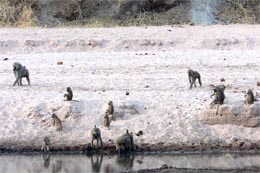
Baboons drinking at river |
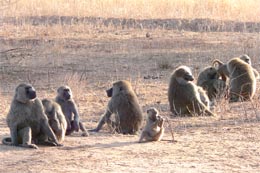
Baboon troop |
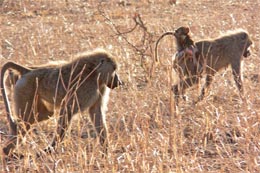
Baboon family |
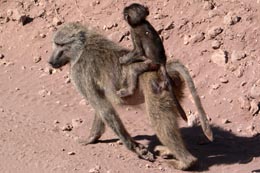
Mom and baby |
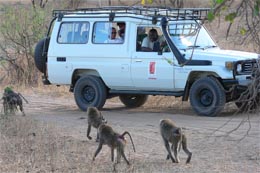
Baboons and safari van |
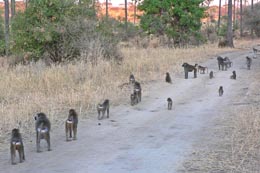
Baboons going home for the night |
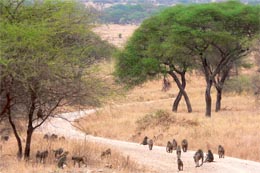
Baboons on road |
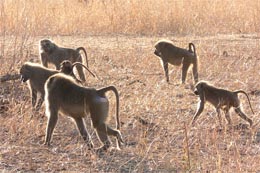
Baboons |
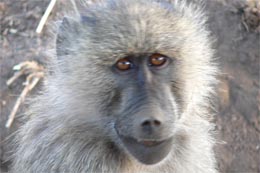
Baboon |
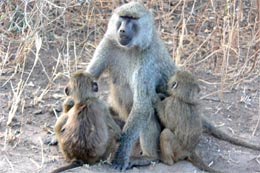
Mom and her kids |
We saw some vervet monkeys with their beautiful little faces tucked away in the trees. I never saw a mother love and hug her baby more than this sweet little vervet mom.
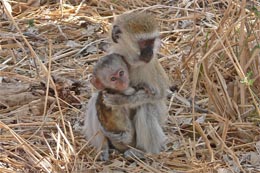
Vervet monkey mom and baby |
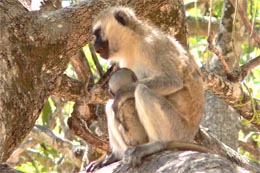
Vervets in tree |
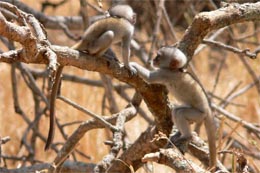
Baby vervets |
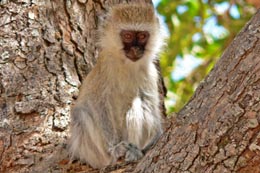
Vervet monkey |
Noticed the monkeys hands with their dexterous digits – need I comment on “un”Intelligent Design?
Elis loved birds so we stopped to view several – although their names and species escape me now – I love the pictures and memories of their little chirps.
In the late afternoon, we returned to our “safe sleeping quarters” for a shower and rest before dinner.
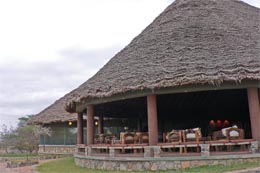
Lobby of Tarangire Lodge |
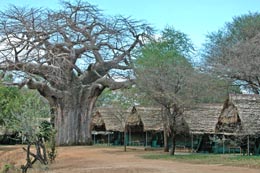
Tents and Baobab tree |
Steve and Daira were in the last tent on the crater rim and we were right next to them. The main lodge and the tents were all lined up on a canyon rim and the views were spectacular! We looked over the valley and down at the river. Sometimes the valley would be loaded with animals. Sometimes not. Sometimes the animals climbed up the crater to tramp through our backyard. Case in point – the terrible leopard story.
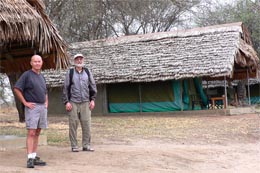
Bill and Steve |
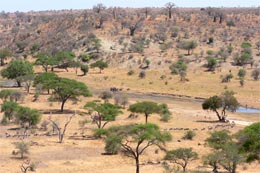
River overlook |
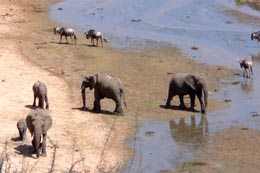
Elephants from river overlook |
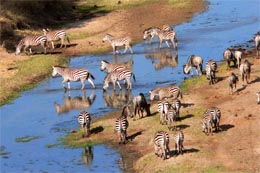
Zebras |
At about 7 pm, we’d meet at the lodge’s beautiful circular lobby for a couple of beers before dinner. After dinner, a guard, armed with a flashlight, would walk us back to our tents in the dark –“a post leopard policy”. It’s a jungle out there.
Tucked away in our cozy little tents, we would listen to lions roaring and elephants trampling across our side yard. They left tracks just to confirm they were there. We also heard hyenas with their strange yaps. The night was so alive with sounds. Bill would be asleep and I would read Hemingway’s “Green Hills of Africa” wondering if I should be afraid or not, but loving every minute. (Hemingway’s book was a poor choice for reading in Africa. I was so upset by his glowing descriptions of killing all these magnificent animals. Why would any one want to harm a zebra?)
10.5.05 – Tarangire to Arusha
We had breakfast, packed up and said goodbye to our friends in Tarangire. One waitress said she’d miss my voice. She always laughed when she heard my high frequency emissions. Africans, with their deep, beautiful voices that resonate with warmth, are fascinated by my squeaks.
We took one last morning game drive with Elis through the Tarangire – and then we were off to Arusha and the Ilboru Safari Lodge.
Elis stopped at a local market to show us the outdoor market where he shopped. He paid someone to watch the van and told us to stay close with him and absolutely NO PICTURES! I wanted to take photos so bad so I could capture this experience on pixels (oops, almost said film) – but didn’t dare. Instead, I bought some fabric from a woman. There were miles of fabric displays, but Elis insisted I buy from this one particular vendor – She must have been his cousin. We were all overwhelmed by the crowds, the smells, the sounds, and the constant activity. The locals were just as fascinated by our white hokey-looking gang. They stared at us as if we had just dropped in from another planet.
We stopped at a very fancy souvenir shop and Cultural Center outside of Arusha. Their claim to fame was that Bill and Chelesa Clinton visited there a few years ago. The story goes that a chief from a tribe offered President Clinton three cows for Chelesa – a very high price in Masai terms. Some in our group went into buying mode while I went into bathroom mode. Lovely bathroom – spent a lot of time in there. Hoping this will pass before the big Kili trek.
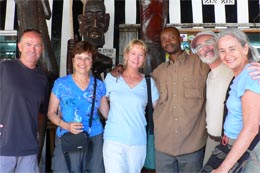
Steve, Mad, Daira, Elis, Bill and Nancy |
Arusha really surprised me. The town was covered in tall, purple Jacaranda trees and for miles and miles, plants in containers lined the roads (like in a nursery) – interesting concept. I got my first good view of a coffee plantation – so many little coffee bushes planted underneath tall trees to protect the coffee plants from the sun. Fascinating views everywhere.
The road to our lodge was amazing – so many locals going about their activities in this busy, dusty, neighborhood. We were a little concerned about what kind of lodge would be located in such a neighborhood .. but tucked behind a big iron gate, was the Ilboru Lodge, a quaint, quiet lodge with bungalows and wonderful gardens – a nice charming, calm environment where we could relax and rest our weary bones.
We finally got to our bungalow (Hut 17), unpacked and then met the group by the pool.
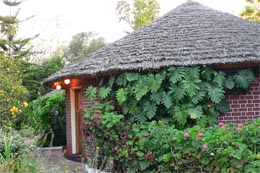
Our room at the Ilboru Lodge |
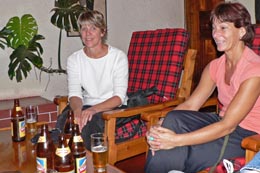
Kim and Debbie D. |
We had a beer, said goodbye to Elis. We begged to have him as our guide for the next day in Arusha, but no dice. Us gals – Daira, Mad and me, gushed and gushed to the Good Earth Rep about what a great guy Elis is. I think we embarrassed the poor Elis.
The Good Earth Reps from Arusha, dressed in their immaculate shirts and slacks, discussed the rest of the trip. Bob leaves tomorrow to start his 7-day trek up Kili on the Machame route. He was thrilled to be on a trek all by himself – he’ll have 7 people to treat him like a king.
Dinner was terrible –very bland and boring. It took them hours to serve all 12 of us. We all got tired of sitting and chatting. Finally, at about 11, the meal was finished and we all went to our rooms to pack (and re-pack) for Kilimanjaro.
10.6.05 –Arusha
NOTE: Bob’s ride to Kili was late – They were caught in traffic in some political rally.
The rest of us had breakfast and then met our new guide for our safari in Arusha National Park. We piled in two vans and drove to the park – a very boring drive – not many animals showed their faces (or other parts of their bodies).
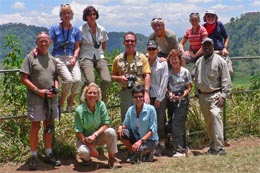
The gang at Arusha National Park |
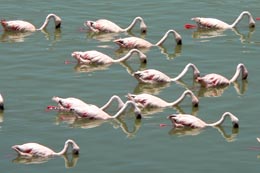
Lesser flamingos |
We had a picnic lunch at the river’s edge while watching flocks of Flamingos.
After lunch, we meet Bennett, a big, tall national park guide armed with a rifle for our afternoon walking safari. Bennett was cool. We were all so happy to be out of the van and actually strolling among the animals. We had been cooped up in a van on safari for the last 10 days. We all secretly hoped that we can make it up Kilimanjaro, given the little exercise and all the food we’ve consumed in the past few days.
Bennett kept an especially close eye on the angry Water Buffalo. We tried to keep down-wind so our scent wouldn’t alarm them. Bennett told us that the lead buffalo would charge for any reason. The gun was there not to shot to kill, but just to fire shots to scare the animals away.
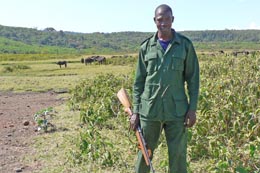
Bennett--our walking-safari guide |
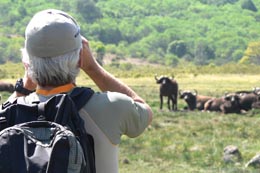
Al taking photos of buffalo |
We were able to walk right up to the giraffes. They covered an entire field. Of course we all took advantage of the wonderful photo ops. (I was sad to be running out of memory – for my photos, that is – so had to limit my shutter finger.)
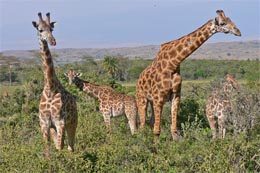
Giraffes in Arusha National Park |
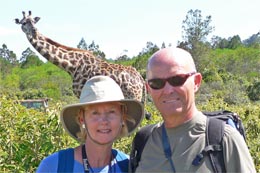
Daira, Steve and giraffe |
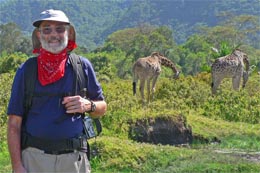
Bill |
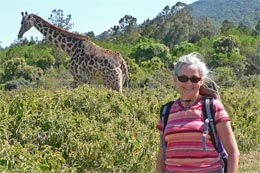
Nancy |
Once during the walking safari, we started to go down a narrow canyon, but Bennett appeared to sense danger and told us to back away. I was scared until Bennett explained later that he didn’t want us to walk through the mud in that particular canyon.
Bennett took us to a gorgeous waterfall. We all took photos of each other and Bennett.
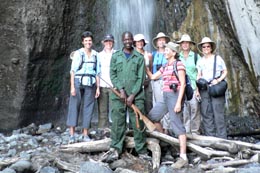
At the waterfall |
We returned to the lodge for dinner. I ordered the pasta – tasted pretty good. Then we went to our little bungalows to finish Kili-packing and try and calm our nerves. We’re all excited about the Mt. Kilimanjaro trek and some of us are down right scared.
10.7.05 –Arusha to KiliDay 1 – Getting There
We were all nervous about the trek. We had breakfast and then deposited our bags for the Kili trek in the lobby. The Good Earth bus arrived at about 7:30 am. The guides and porters poured into the lobby picking up our luggage and stashing it on the bus.
Godlisten was our lead guide. When he was born, his father said God listened to him and gave him a son like Godlisten. God must have listened to us and gave us a leader who would make our journey to the mountain successful.
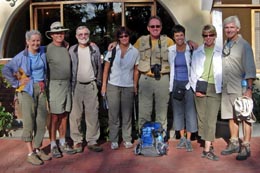
The Gang ready for the trek |
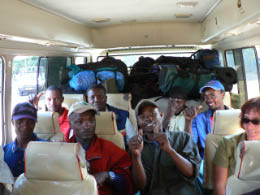
Driving to the trail head |
Finally we were off for a 6-hour drive to the Naremoru trailhead with a few stops in between – a stop at the Marangu Gate to sign in and pay the park fees, a stop for lunch, and a stop to jam even more porters into the bus. Godlisten selected the extra porters from a larger group waiting in Marangu town.
We ate our picnic lunch in a little town at an “outdoor café.” We were serenaded by cool African tunes emitted by big speakers made from barrels and anchored to a bicycle. I loved watching the colorful locals dancing in the street.
Back on the bus, everyone was feeling happy, laughing, practicing our pitiful Swahili and sharing snack food with our new companions. The lead guide, Godlisten, was sitting in the front seat like a head cheerleader keeping spirits up. (Assistant guides Prosper and Emmanuel, also called Manu or Enrique.)
With little fanfare, the dusty bus pulled up to the trailhead and at 3 o’clock in the afternoon, our trek up the mountain had officially begun.
Our gang of 8 put on our backpacks, adjusted our hiking poles and followed Godlisten slowly up the gentle path. Assistants Guides Manu, fun-loving and spirited, and Prosper, sweet, shy and quiet, followed behind us, probably trying to figure out this fresh new crop of clients.
We left the twenty-some odd porters back at the bus to collect all our stuff and then add more stuff required to sustain us for 6 days on the mountain. These guys are tough!
We hiked through fields of maize and potatoes dotted with cows and goats and sun-baked huts, homes to the farmers and their families. The children are accustomed to strange foreigners with hiking poles invading their land and ran up to challenge us to a race, but our rhythm on the mountain was “poli-poli.” Swahili for slowly-slowly. Godlisten told us “If you go poli-poli, you will make it to the top”. The mountain chant was poli-poli and we poli-poli we would go!
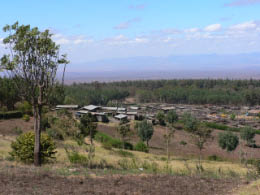
Village near trail |
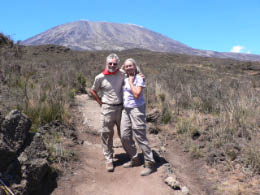
First day on the trail |
A mile or two down the trail, we stepped aside to let the crew of porters pass, all piled high with our supplies. No poli-poli for them. They had work to do – dash ahead to our first campsite, set up our tents, prepare our dinner, gather water – the list goes on. By 6 o’clock, they were ready for our arrival.
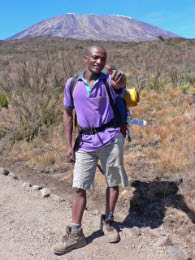
Manu |
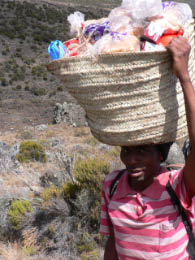
Porter carrying our food |
We spotted our cozy campsite at the edge of the moorland with views to the north of Kenyan plains. It was very inviting with yellow tents for sleeping, a big blue tent for dining, and extra tents for the kitchen and for the guides and porters. A big operation, managed by the CEO Godlisten, was required to sustain us 8 poli-poli hikers.
At the campsite, we claimed our tent, got our luggage, laid out sleeping bags, changed to warm fleece and put on extra layers for the evening chill.
We were summoned by the call “Water for washing.” Pouring warm water over our dirty hands became a special morning and nightly ritual.
In the dinning tent we found hot popcorn, cookies and a selection of hot drinks.
About an hour later, we ate a huge, delicious dinner. We all shouted praises to our new Chef, Dismus. He was small thin quiet guy who took great pride in his culinary creations.
Each dinner was as good as the night before. Manu guided us on the trail, but at the campsite, his role switched to head matre de, serving us with class and charm.
Dinner started when he ladled hot soup into each of our bowls. That was only the beginning. He brought platters of food from the kitchen -- bread or crepes, cheese, fish, pastas, curries, cabbage, carrots, potatoes, cucumbers, tomatoes, fruits and so on.
Godlisten made a habit of popping in after dinner to check on everyone. After a little kidding around, he would announce the schedule for the next day and repeat his instructions for success on the mountain -- Eat a lot, drink a lot and “poli-poli.” And we faithfully followed his orders.
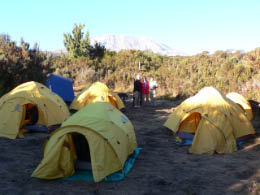
Our First Campsite |
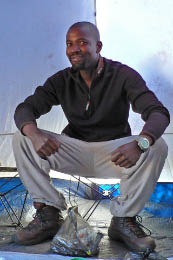
Godlisten giving us advice |
He recommended drinking 4 liters of water a day. The porters’ job was to gather water, often hiking for miles uphill to collect it (from a lake or stream), carrying it back and boiling it. Our job was easy -- treat the water with iodine tablets and make sure we drank it.
That first night we smuggled happily in our sleeping bags knowing we had a good leader and a good company who would take great care of us on the mountain.
10.8.05 – Kili (day 2)
“Water for washing” was our wake up call.
We gathered in our dinning tent for breakfast. Manu greeted us with a big smile and hot bowls of porridge served with toast, cheese, hot drinks and fresh pineapple. When we felt we couldn’t eat another bite, he returned with omelets and sausages. I thought I’d explode, but I stuffed it away.
Sometime that morning, I became BiBi, Swahili for grandmother. The nickname stuck and I was forever BiBi – BiBi to the guides, to the porters and to my hiking buddies. It wasn’t just BiBi, it was “BiBi” (high pitched). All over Kenya and Tanzania, my high-pitched voice was distinctive to the Africans blessed with their deep, mellow, resonant low tones … and Kilimanjaro was no different.
Let’s face it, I was an oddity. Older, gray hair women with squeaky voices are not normally found on the mountain. My girlfriend trekkers were all beautiful and younger, but it was the old BiBi who stole all the attention.
Before long, Bill was dubbed Babu – Swahili for grandpa. Zi’s NiNi and PaPa were now BiBi and Babu.
Godlisten summoned the troops with “twenday” – “let’s go” in Swahili. He tried to teach us Swahili, but the challenge proved to be too great for us mono-language types.
Godlisten was always in the front, followed by the poli-poli pacesetter Bibi, followed by the rest of our fellow trekkers followed by Manu and Prosper.
Our group was playful – singing, laughing, and joking. I tried to focus inward, staring at Godlisten’s boots moving ahead one step at a time. I coordinated my yoga breathing with his pace and added my secret walking mantras. Sa Ta Na Ma for slight inclines and Sat Nam for the steep inclines. This helped crank the old BiBi engine into gear.
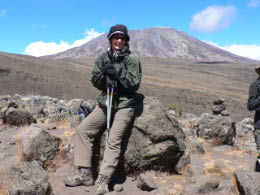
Debby D. |
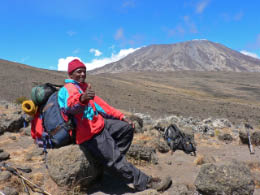
Manu |
Occasionally Godlisten would interrupt my mental Sa Ta Na Ma’s to engage me in an imaginary soccer match by kicking a stone into my path – and I would kick the stone back – a little fun to break up the boredom.
We made the occasional stops for snack, lunch, bathroom, water and/or photo ops.
The morning climb was a steady ascent with views of Kili’s two major mountain peaks – on our right was Kibo and Eastern ice fields on the crater rim. Straight ahead was Mawenzi with its dramatic peaks and jagged rock
The thin scrubby vegetation at last night’s camp now gave way to a moorland zone, then a rugged, harsh terrain that looked like a moonscape.
The Rongai route was pure magic because not many people go this way.
I felt like a wilderness climb and we had Kili all to ourselves.
Godlisten would stop to share some of the wonders of his mountain
A rare plant --
Or a chameleon clinging to a branch,
Or a lava rock to remind us Kili’s violent creation.
But most of the time, we kept moving, poli-poli up the mountain. After long stretches of silence, Godlisten would lead a cheer –
“Everybody Say BiBi”
“Everybody Say Babui”
“Everybody Say Hawaii”
“Everybody Say Manu”
“Everybody Say Poli-Poli”
And the list went on -- I don’t know why something that stupid united us all in laughter on the trail.
Each day the porters rushed past on the trail. We stepped aside while they greeted us with Jambo, Jambo or Poli Poli’s – accept when they passed me – BiBi – Jambo BiBi. Before long I was Queen of the Mountain.
In spite of their heavy loads and hard work, the porters seemed to have a good time. Godlisten would sometimes translate their comments to us – They said, “Dismus, the skinny cook has a wife the size of a Baobob tree.” Then we’d join in their laughter.
Mid-afternoon I came around a bend and spotted our campsite – yellow and blue tents tucked away in an isolated valley. What a thrill. It wouldn’t be long for the call: “water for washing”
And then sitting down for hot drinks and popcorn and cookies in the dinning tent, we’d recap our day, and check on how everyone is feeling. We needed the chance to re-charge our batteries before the second acclimation hike up the mountain. For another hour or two, Godlisten would lead us a few hundred feet to higher ground. When the watch altimeters clicked to a round number, we’d all celebrate our new record, then return to camp to stuff ourselves with dinner.
In spite of his fun-loving nature, Godlisten had us on a serious training regimen. An important part of acclimation is “hike high, sleep low.” It must be working because no one is sick and no one is taking diamox.
After dinner, Babu joined some of the gang in the dining tent for a friendly game of hearts. From my yellow-tented cocoon, I eavesdropped on their conversations. After they stuck Debbie with the dreaded queen, they captured a frightened little mouse and put him in an almost empty can of hot chocolate mix. For the rest of the trip, we held our breath when we opened a can of chocolate mix.
Beyond the craziness and commotion of the card sharks and great white hunters, I heard our hosts talking in Swahili punctuated with laughter.
Laughter was the common language spoken that night and I observed it all from the isolation of my little tent.
Lights out about ten. Silence fell over our camp. In the middle of the night, nature called so I stumbled out of my tent. Oh mercy – a host of stars from the southern hemisphere shined down on me. This can’t be real.
10.9.05 – Kili (day 3)
Another beautiful sunny day and another huge breakfast.
We were all feeling grand -- healthy, happy, and strong in spite of the fact that our personal hygiene was suffering.
Babu and I learned that ten handy wipes skillfully applied to various body parts followed by a deodorant chaser will actually leave you feeling refreshed.
For lack of a better term, toilet facilities were at each campsite, but most of us preferred using the fresh scent of the wide-open spaces.
I had to stop for several potty breaks on the trail thanks to the mass quantities of food and water I was ingesting. I grew accustomed to flashing my big ole’ white butt all over that mountain. When we ran out of bushes and big rocks to hide behind, I’d yell “Everybody look the other way.” It had come to this.
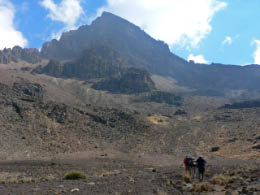
Hiking toward Mawenzi |
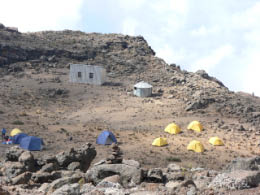
Our camp at the tarn |
We spotted some huge Lobelias and Senecios Kilimanjari (or is it Giant lobelia deckenii?) covered by the morning mist. They are a great looking pre-historic plant that grows to over 15 feet tall.
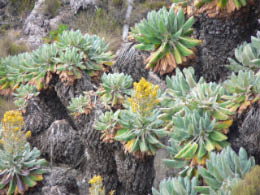
Giant Senecia |
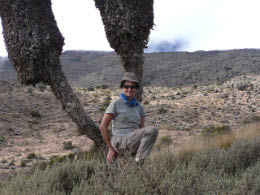
Nancy taking a break |
By midday, we passed through the plant zone and into some very dramatic scenery that looked liked something straight out of a JRR Tolkien's novel. Mawensi, the second highest peak on Kili, is made of pointy peaks and big jagged rocks. Babu was thrilled to see our little campsite nestled in the shadow of the peak, next to Mawenzi Tarn. He read so many books and studied so many maps and now the place was real.
The routine was set – popcorn, cookies and hot drinks, then the afternoon acclimation hike before dinner.
We bounded up the jagged trail, setting a new record – 15,000 feet. We gasped at the breathtaking views of our campsite and then together we built a mini rock tower. Life was good until the big cloud moved in. Weather changes very quickly in the mountains.
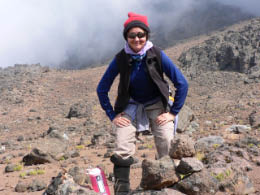
Nancy at 15,000' |
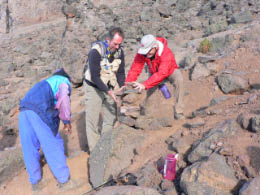
Building a rock tower |
We hurried down the trail, feeling rain drops, then ice and snow on our faces. Luckily we were huddled in the dinning tent over hot bowls of soup when the real snowstorm hit. We watched the snow and sleet blow at a 45-degree angle right outside our dinning door. Mother Nature had turned on us. No one wanted to hang out for an evening game of cards.
We each curled up in our tents coated with ice and snow.
The potty break in the middle of the night was painful – No magnificent stars shining down on me -- only cold ice snow and sleet blowing on my butt.
10.10.05 – Kili (day 4)
Sunshine, glorious and blinding sunshine with blue skies overhead. The storm had dusted the brown hues of earth and rock with a beautiful white layer and the views were breathtaking. We couldn’t take enough pictures of Mawenzi and Kili.
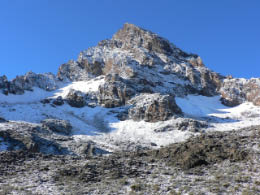
Mawenzi Peak |
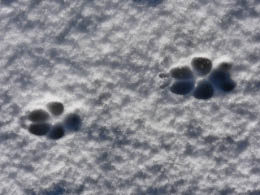
Whak kind of animal visited last night? |
We ascended a ridge and reached the lunar desert of the saddle between Mawenzi and Kibo – not far now. However, my secret chant and breathing techniques weren’t working. Maybe it was the oxygen level or maybe the BiBi engine was wearing out.
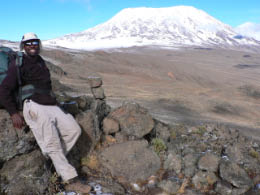
Godlisten on the ridge |
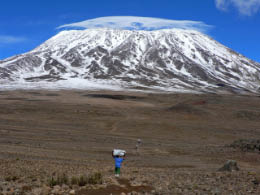
A view of Kilimanjaro from the Saddle |
We arrived at Kibo Hut about 2 o’clock. It was grand central station. Our isolated, wilderness trek on the Rongai Route was now over.
We signed in with the crowds from the other companies. I dug out my lucky rabbit fur hat for the chilly afternoon and then we posed for the obligatory picture next to the sign. We had accomplished a major goal.
I passed on the afternoon popcorn break and went back to my tent to lick my wounds and try to get my things organized for tomorrow’s summit day.
Storm clouds were moving in -- maybe the afternoon acclimation hike would be cancelled. No such luck we gathered at 3 for a climb above Kibo.
The cool air revived me and I managed to keep up with the gang. Godlisten generously offered to carry my pack up the mountain for tomorrow’s big day. With 15 pounds lifted off my back, I just might make it.
Dinner was followed by a little pre-birthday celebration. I loved the sweet cards and a lucky necklace and the t-shirt designed by Babu that says “Nancy, Queen of Africa – 2005.” I shared lots of tears and hugs with the wonderful new family I had found on the mountain.
Godlisten stopped by for his nightly pep talk. “You have done everything and you’re ready for the mountain top. Don’t be nervous. Get some rest. Wake up call is at 11:30 pm.
I have done everything Godlisten has said – drink lots of water, eat lots of food and poli-poli – but try as I may I could not calm my nerves and get any rest.
I ground my teeth, I took several potty breaks – I was a mess. I was happy when the 11:30 call came because I could finally stop tossing and turning.
10.11.05 – Kili (day 5)
Babu woke up feeling strong and wished me a happy birthday. He knew I was in trouble and asked if I couldn’t make it to the top, would I mind if he went on – OF COURSE NOT. I would not take Babu’s dream away.
Manu brought tea and biscuits to our tent and Godlisten picked up my overstuffed pack. I was a mess – one boot unlaced, headlight on upside down, my lucky rabbit fur hat falling off my head.
The campsite was so eerie under the moonless sky. The only lights you could see were the stars up above and the headlights of the dark figures gathering to make their ascent to the top of Kili.
At midnight, our gang of 8 took our places in single file behind Godlisten and started up.
We plodded slowly up in the darkness on a switchback trail through rock and loose volcanic scree. Looking down all I saw was Godlisten’s boots and a steep rocky trail illuminated by our headlights. When I glanced up I saw lines of headlights snaking their way straight up into the stars,
I wasn’t functioning well. Bill tried to coach me – “Alternate your poles with your steps. Try to stay on the trail.” I found this coaching very annoying.
My 60-year-old body and mind were not cooperating. I just wanted to lie down and go to sleep. I couldn’t find my rhythm and was holding the rest of the group back.
Finally Godlisten instructed Prosper and Manu to take the rest of the group up – and he would stay back with BiBi and my poli poli pace. Babu’s parting words to Godlisten were: “She’s very stubborn so watch out for her.” Godlisten replied forcefully, “I know. I am a guide.”
With that Godlisten and I stepped aside to let the rest of the group pass. They all wished me well.
Godlisten stopped several times to let me catch my breath and drink some water. It wasn’t long before the water in the bladder frozen. It was cold and dark.
Finally, when we passed the 17,000 feet, my spirit left me. I was 3,000 feet higher that Mt. Whitney and that was good enough. Godlisten was disappointed and tried to coax me – “Don’t you want to see my office – It has a very nice sign.”
Nope, I’ll catch it another time. I wanted to go back down to the camp while I still could walk. I didn’t think Godlisten could carry both me and my pack all the way down.
Godlisten was dejected leading me down that steep, dark barren rugged landscape. Lines of hikers passed us on their way up to the stars. I felt I was the first survivor voted off the mountain. The tribe had spoken and my torch was extinguished.
Before I knew it we walked another mile down that steep trail clinging to the mountain. We were slipping and sliding on the rocks, hanging on to each other; laughing each time we pulled each other down.
Somewhere in that dark cold night I announced that this was the most amazing night in my life – Here I am at 2 o’clock in the morning on my 60 th birthday, standing on Mt. Kilimanjaro with the sky loaded with stars. What could be better? Then we screamed into night air – BiBi is my friend. Godlisten is my friend. As we finished our descent I gave Godlisten my lucky rabbit fur hat.
On summit morning, the porters sleep in our nice tents with thick foam mattresses. Godlisten asked if I minded sharing my tent with the porter already asleep in tent. How could I disturb that hardworking kid that schlepped my stuff all over the mountain? So I quietly nestled into my sleeping bag, trying not to move and wake him. A few hours later I finally got to sleep. Then the words, “Good Morning BiBi” awakened me. With that, the young porter rolled up his sleeping bag and left. This was truly a strange birthday.
I lay in the tent motionless wondering about Babu. Finally at about 9:30 am, Bill came down – 5 hours up, 1.5 hours down. I heard Godlisten calling, “BiBi, Babu is here.” I was so happy to see him and hear about his night on the mountain.
I ran out to greet him. He said he’d never walk again. He took off his layers of sweaty clothes. I hung them on the tent to dry. Then I rubbed him down with Mary’s magic cream. He had only a couple of hours to rest before the 8-mile trek out of here. He was so excited and I was so proud.
Babu was the champ – the king pin on Kili. He followed behind Prosper’s green and white stripped gators, encouraging the gang up the mountain.
NOTE: Steve made it to Gilman’s Point and then turned back because he was low on water. Leo and Debbi made it to the summit later, after resting a while at Gillman’s Point.
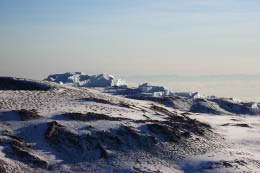
Bill's photo from Gilman's Point |
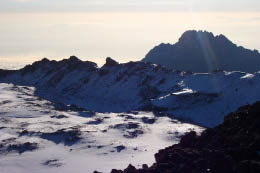
Bill's photo of the crater |
NOTE: Our gang met Bobby on the summit – He made it, but had 2 days of rain.
After Bill and his gang summited, he wanted to hurry back down to check on me. Kim told me that the gang told him to go ahead and he dashed off. They were so glad he was gone so they could take a breather. Al, the iron man competitor, asked Bill to share with them his training program.
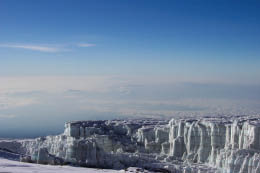
Bill's photo of the glacier on Kilimanjaro |
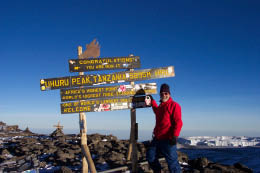
Bill at the Summit |
I was so proud Bill and all of my colleagues for making it all the way to the top. Some came down more wounded than others. Bill was in top shape.
The day’s schedule was grueling. My buddies who had already hiked 8 hours to the top returned for an hour to rest before our hot lunch was served. Then it was another 8 miles down the trail for our last campsite on the mountain. A few in the group looked like they would never walk again.
I was the only one looking forward to the afternoon hike down the mountain – I suppose there are some benefits to not climbing every mountain.
We were now on the Coca Cola route – a regular highway loaded with hikers dressed in their latest gear supported by guides and porters dressed in cast offs from former hikers.
Godlisten was really working us on the trail – talking about how hard it is to get ahead – house payments, education for his children (3 of them plus a new baby) and that he wants to open a grocery store. He told me, “Some people send him money.” He said he likes Americans – They pay their bills, not like Italians and Japanese.
Our porters passed us – Today it was “Happy Birthday BiBi!” I’m going to miss being queen BiBi on this mountain.
The day was bright and sunny and the trail was all down hill to our final campsite at Horombo (12276ft).
Horombo was located on a beautiful cliff overlooking the town of Marangu. We had a flush toilet (that was broken) and an outdoor cold-water spigot. Debbie Hawaii and Kim (and then Leo) actually washed their hair and took a shower in that icy water. Wipees would hold me for another night.
We signed in and then I privately ordered some “blackmarket” Kilimanjaro beer for after dinner to celebrate everyone’s success and to celebrate the end of my birthday – it had been a very long day for everyone – but we were a happy group – with lots of love and some energy to share. Godlisten took me aside and said it was illegal in the park to have beer, but he led me to a guy in a hut who said he could get me anything I wanted – beer, chocolates, etc. I said, “just beer and make it cold.” (Only $3 per beer and that meant someone had to hike about 15 miles for it.)
Godlisten asked that we figure the tips that night because some of the porters had to leave early. Manu gave us a list of all the job categories. Al, the accountant, lead the meeting in the tent after dinner. We gave 40% more than Narry’s highest recommendation.
Wasn’t very hungry and didn’t have to stuff myself – so only ate a little. After dinner, the black market Kili beers arrived for our group and Manu, Prosper and another guide. I showed them postcards and pictures of ZiZi. Bill thought showing the postcards was a bad idea and only emphasized the discrepancies in our life.
Afterwards, outside of the tent, the porters heard their tips read off and then hugged and thanked us. I think they were happy.
I was sad this was our last night with the wonderful new friends we met – but I knew a hot shower was less than 24 hours away!
10.12.05 – Kili (day 6)
Another beautiful day – sunny and warm (12,000 ft.) Our last breakfast – I stuffed myself with porridge, eggs (still available), hot dog, toast, chesses, and coffee. Then we headed out at 7:30 for our final hike on the mountain.
We descended steadily down 11 miles through five eco-systems – alpine desert, moorland, heather, forest and cultivation. Loved going from moonscape to rain forest. Everyone was happy with such a sense of accomplishment.
Porters were everywhere with their high pitched “Hi BiBi’s.” Godlisten was jiving and Bill was taking lots of video. The forest / jungle was a welcome change from the dry, dusty alpine desert Graceful trees and vines formed a canopy over the trail and the sounds of monkeys and exotic birds hidden in the trees were magnificent.
Godlisten was particularly playful and our group joined in. It was time for fun and celebration and some pure silliness.
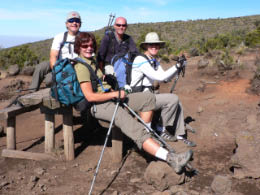
Taking a break on the way down |
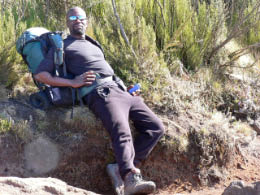
Godlisten |
We stopped at Mandara Huts for a picnic lunch. Godlisten changed his shirt, then put on my rabbit fur hat and made strange animal noises. It was funny.
NOTE: Back in San Diego, I chuckle when I think about that lucky rabbit fur hat that I bought at a mall in Southern California making its way up the mountain for years to come.
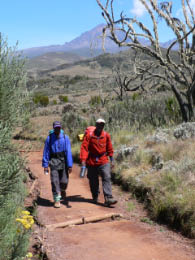
Prosper and Manu |
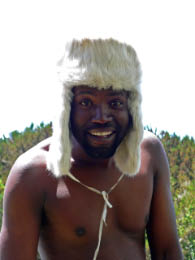
Godlisten and my rabbit fur hat |
There were t-shirt / hat vendors who surrounded the lunch group. We were almost running through the rainforest. Steve’s knees were giving out.
The vendors (illegal in the park) were holding us up so Godlisten grabbed one and pretended to beat him up.
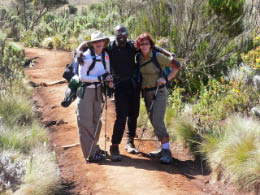
Kim, Godlisten and Debby D.
|
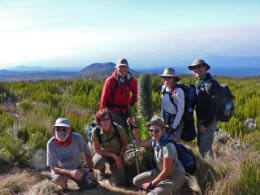 Posing for a last photo opp on the trail
|
The 6-hour hike was over before we knew it as we passed through the National Park gate at Marangu about 1:30. The porters took a quick shower to get ready for the closing ceremonies.
The Park issues certificates to those trekkers who reached the top. Godlisten presented the awards. The ceremony was a perfect ending to a wonderful adventure. I videotaped it all.
Kilimanjaro give us each what we were seeking.
Babu, my Bill, led the way to the top with such strength and energy and encouraged the others along the way.
Steve completed his goal – made it to Gilman’s point on strong legs he had developed to match his swimmer’s upper body.
Debby Hawaii found her power to the top for the spiritual connection with her husband – she left his ashes and her long ponytail.
Kim and Al made it up together to share another amazing accomplishment in their life.
Finally, Leo and Debby dug deep within themselves to find unknown power as they willed themselves up to the top.
Although I did not make it to the top, Kilimanjaro made me feel young and strong like a buffalo – a beautiful gift for a 60-year-old BiBi.
Babu and I made a strong connection with our fellow adventurers and our African brothers who made the dream come true.
The fun continued on the 3-hour bus ride back to Arusha and a waiting shower.
We all climbed into the bus and headed back to Arusha – all happy, bouncing along and listen to African tunes on the radio. Reality struck when we heard about an earthquake in Pakistan – Death toll at 39,000 – first news in a long time. It reminded me what the world is really like.
We dropped some porters off and stopped at a money exchange so the porters could exchange in their dollars.
While we were waiting, Debbi helped me pick out some cool bracelets at a “going out of business” store.
We got back to the Lodge at 4:30. The porters unloaded the bags and we said our final good-byes in the hotel lobby. They would return to their homes and families before their next climb and we would return half way across the globe to our families and our lives. Sad to see the adventure end.
We got our same bungalow - #17 – only this time the adjoining room was turned into a suite for us – wine, TV, bar. We were excited, but the excitement didn’t last long. Got the phone call from the front desk – they had given us the wrong room. We were only special for about 15 minutes!
Got settled into the right room and put all our dirty, sweaty and yucky clothes into sealed vacuum bags. I did an outstanding job of packing an elephant into a suitcase.
We got a call to meet our friends in the lobby for a dinner out on the town, but Bob didn’t pass the word along to us. Since we had pre-ordered pasta at the lodge, we had to eat there while the others all took off for a delightful evening – BBQ on the streets.
We had a quiet dinner with a pudgy 60 year old from Pennsylvania. He said he climbed Kili and was putting together a program to raise money for the Boy Scouts.
All ready for Zanzibar – our last adventure in Africa!
10.13.05 – 10.16.30 – Zanzibar - Last Leg of our trip
Pongwe Beach Hotel
Zanzibar was exotic and the Pongwe Beach Hotel was a true paradise. We stayed three nights to relax and recover from our Kili trek – a perfect ending to a grand adventure.
Pongwe Beach’s main lodge, guard house, huts, surrounding gardens, white sands, turquoise water, and a most picturesque boat docked right off the shore were materials for any classy, high-gloss postcard. The following pictures say it all.
Our Zanzibar Hide-Away
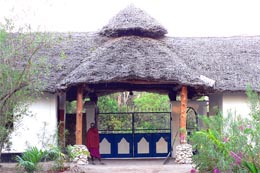
Pongwe Beach Hotel Front Gate |
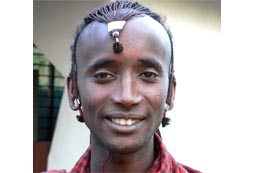
Masai Guard at Pongwe Beach Hotel |
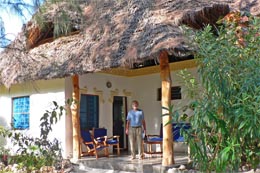
Bill on our porch |
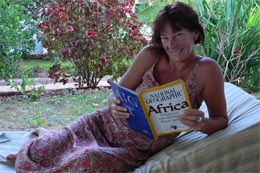
Debbie D. |

Pongwe Beach Hotel Gardner |
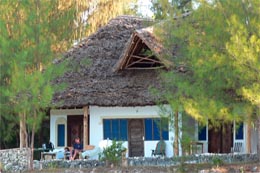
Leo and Debbie's room |
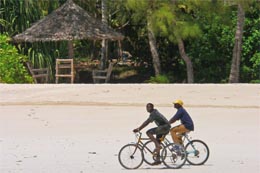
Locals biking on the beach |
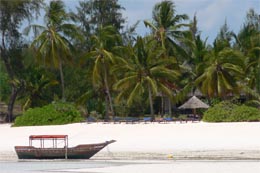
Boat in front of hotel |
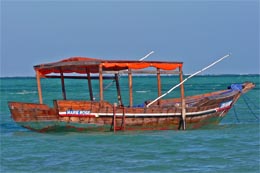
Fishing boat |
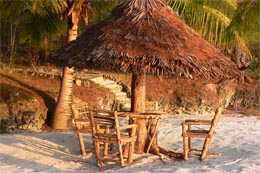
Hotel beach |
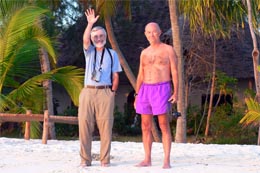
Bill and Steve |
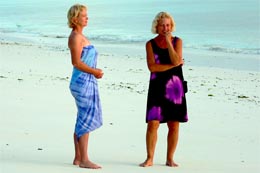
Daira and Sherry |
Morning Beach Walk
The first morning on Zanzibar, Leo, Debbie, Kim, “Hawaii,” and Bill and I took a wonderful stroll up the beach. They waited for me to recover from a case of the runs.
NOTE: The other half of our group opted to go on a boat ride and snorkeling day trip with a huge lobster lunch included – given my delicate condition, I’m sure glad we stayed behind.
The stroll up the beach was relaxed and a perfect way to spend the morning. We saw the locals fishing, women harvesting kelp, and children playing. It was in a most beautiful setting. We gathered amazing shells.
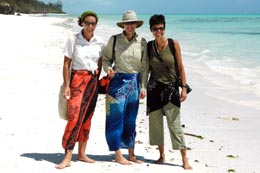
Debbie D., Kim, and Debbie L. |
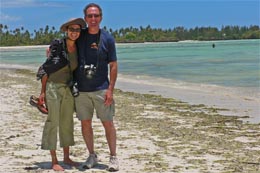
Debbie L. and Leo |
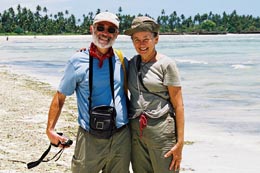
Bill and Nancy |
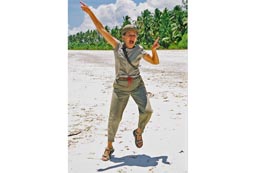
Nancy acting crazy (too much sun?) |
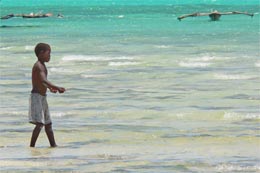
Boy fishing |
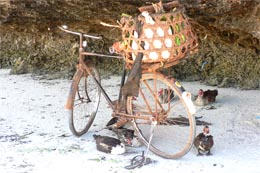
Bike on beach |
Bill and I spotted a group of kids doing somersaults on the beach. We went up to them to make friends. They counted for us in English and practiced their English words. There were four girls and 1 boy. When we left, I gave the 4 girls each a doll and the boy, my sunglasses. The kids were thrilled. One little girl was literally jumping with joy. It made us all want to cry.
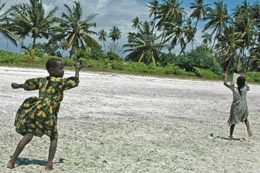
Kids playing on beach |
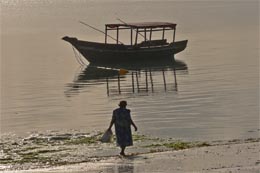
Woman collecting kelp |
We came back to the lodge on the high ground because high tide had flooded the beach.
We spent a lazy afternoon hanging out in our little bungalow. Bill reviewed the Kili video and I read part of a book I grabbed from the lodge library. It was about trading in Africa from 1760 – 1790 or so. It was published in 1970. Letters from the authors were tucked in the book along with handwritten manuscript notes – a most pleasurable afternoon visiting ghosts. It was like a tour through the British museum only with a guide pointing out the key stuff. (Later I returned the book to the owner. He said his mother buys armloads of used books from thrift shops in England and ships them to him.)
We had a big celebration on our second night at the lodge. Bill and I ordered a cake (flour less chocolate) double ring with the words:
Bob and Mad – 43 years
Daira – 60
BiBi – 60
Kim – 50
The food at this place is very gourmet and the flourless cake was yummy!
We exchanged cards and made a big deal. Bill and I got a little tipsy.
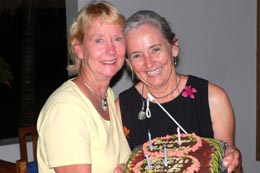
Daira and Nancy with cake |
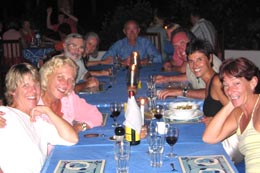
Celebration dinner |
NOTE: We got to know the owners and the place pretty well. Phil, the manager, is very “Tony Blair” British and keeps us laughing with his dry humor. Val, the overweight owner, is always drinking a highball while he works at the computer in his office. Poor Val was a silent partner in the resort deal until he was forced into an active role. They almost lost the place when his buddies blew the startup money on water sports. Phil and Val both are concerned not only about their paradise resort, but also about the entire island. They pay villagers $1 to pick up trash along the road and provide medical care for their employees. They are especially concerned about their gardener who has bouts with maniac depression.
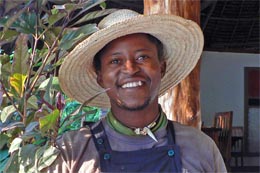
Gardner |
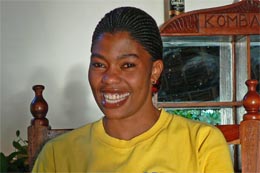
Waitress |
10.15.05 – Zanzibar – Spice Tour (Stone Town)
Spice Island Tour
On the second day, Bill arranged a Spice Tour with Mr. Metu in Stone Town. It cost $10 for a tour and lunch. A taxi picked up our gang of seven (Leo, Debby L., Steve, Kim and Debbie Hawaii) at the hotel after breakfast and delivered us to Mr. Metu’s office in the heart of Stone Town. There we transferred to other vans for our tour of several plantations and historical sites. We saw the baths the Sultan built for his wife. He also had 99 concubines.
Furar was our guide. He was terrific – knowledgeable, quiet, dignified and read Donald Duck comic books on the way. He has two kids – a 9-year old girl and 4-year old boy plus one wife. He said he only wants one wife – that’s enough! He stopped along the way to show us his house. He was so very proud of his home. He is constantly making additions to the place. We met his wife and sister-in-law and saw their cozy living room with a big old TV – life is good for Furar’s family.
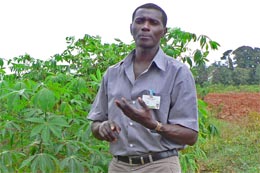
Furar, our Spice Tour guide |
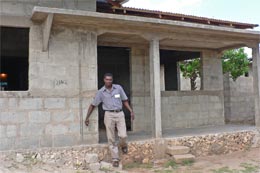
Furar's house |
We made several stops at various plantations where Furar told us about:
The 500 varieties of Cassias trees, cinnamon (eat the bark), nutmeg (aphrodisiac), quinine tree for malaria, pepper, spinach, soap berries, allspice, lemon grass, ginger root, coffee, bananas, bread fruit, durian, and many others.
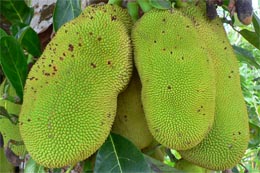
Durian fruit |
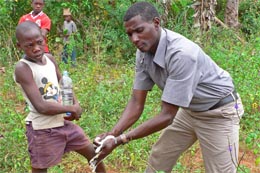
Soap berry demonstration |
At the end of the tour, some young boys who followed us around made necklaces and rings for us out of the leaves they gathered along the way. Of course, they waited for a tip for their gifts.
We stopped at a little village nestled in one of the plantations to buy some packets of the different spices and watch the children play. The combination of Arab and African produces makes some mighty gorgeous people.
We had lunch cramped into a little house. The lunch, prepared by a couple of local woman who live in the house, was great. We gobbled down the curry, rice, spinach, naan bread, and drank the cokes. Usually, people on the tour eat outside, but during Ramadan (every October), no one eats until after sunset – so we had to consume our lunch, hidden away and out of the view of the locals.
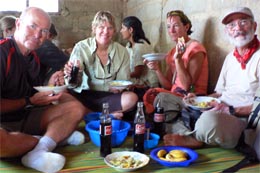
Lunch on Spice Tour |

Lunch stop kitchen |
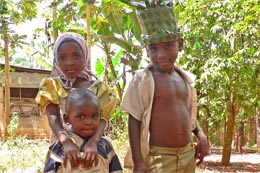
Local kids on Spice Tour |
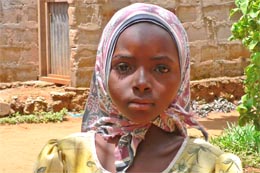
Beautiful little girl |
Three hours in Stone Town
After our lunch, the van dropped us off in Stone Town with only three hours to do the town. Steve, Bill and I took off together while the others explored on their own.
Stone Town is built on a triangular peninsula. The architecture is mostly Arab blended with Indian and European influences. The combination is a very exotic place indeed. The views out to the ocean were colorful, but the old crumbling town, only hinted of glorious and grand yesteryears.
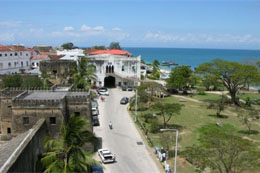
Stone Town |
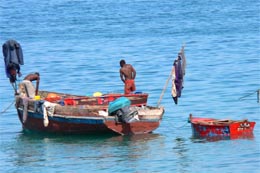
Stone Town Harbor |
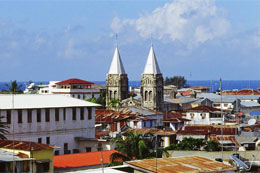
Stone Town |
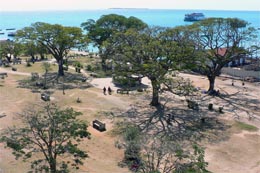
Stone Town park |
Our first stop was the House of Wonders – the meeting house built for the Sultan which now serves as a museum. It was built on a grand scale and one of the first buildings on the island to have electric lights. From the dusty museum displays, we learned about Oman Arab domination. We studied the photographs of the Sultans who ruled here. Zanzibar was ruled by 11 Sultans. We saw the rooms they occupied, the ornate coffee and teapots, and beautiful fabrics they used. A large old important boat sat proudly on the main floor of the museum. (Can’t remember why it was important.)
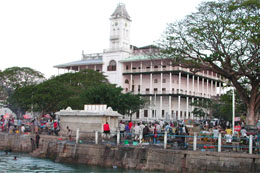
House of Wonders |
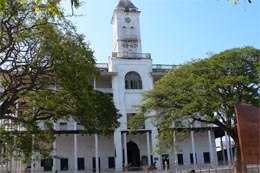
Front of House of Wonders |
The next stop was the Palace Museum. The place was once magnificent – but now really worn out. (Compare my photo with an old black and white postcard.)
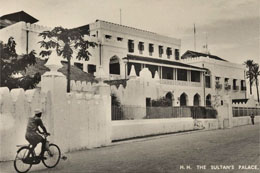
Palace Museum--Old postcard |
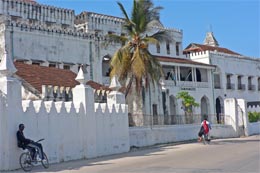
Palace Museum--Nancy's photo |
The worn out old museum housed some interesting stuff -- a portrait of the Hapsburgs – Frederick and Elizabeth – given as gifts to the Sultan, opium pipes and flasks for carrying opium, a rugged, faded old throne chair still used for conferences, a room dedicated to one of the Sultan’s daughters who married a German diplomat (must read her book – Memories of an Arabian Princess) and side by side setting rooms each decorated in two different styles by two different wives of the same Sultan – one was flashy, one was traditional and conservative.
The weather was hot and humid and with no air conditioning, we were dying in the museum. No one is allowed to drink or eat while the sun is up during Ramadan. At the Palace museum, we apologized to our guide in advance, but said we needed to drink some water. He was OK with us standing in a dark corner and gulping down water from our water bottles.
The next stop was the Arab Fort – built by the Portuguese in the 1700`s, enlarged by the Omani (Arabs) and later used by the colonial British. The decaying Arab Fort now houses an insignificant museum and junky souvenir and food stands.
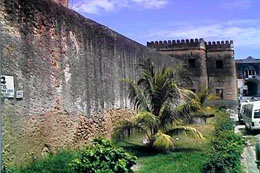
Arab Fort Walls |
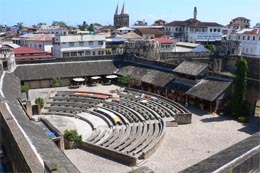
Arab Fort |
We only walked through the Arab fort and on to the old Anglican church. We paid a fee to go down into the basement to see the holding places built for the slave trade. Horrible site – we sat quietly in that hot, humid basement thinking about the terror people must have felt.
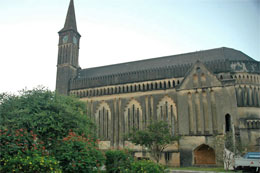
Anglican Church |
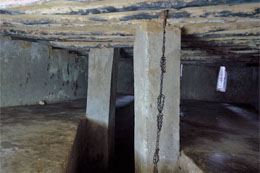
Slave Quarters |
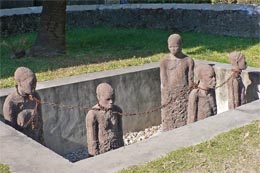
Monument to the Slaves |
Next, we walked through the narrow twisting alleyways of exotic old Stone Town, marveling at the heavy carved doors and heavily veiled woman. The place was bustling with markets and souvenir shops. We hit a couple of the shops and then we checked Stone Town off our list.
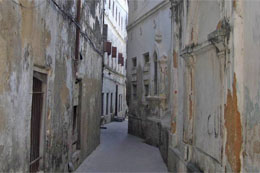
Narrow walls in Stone Town |
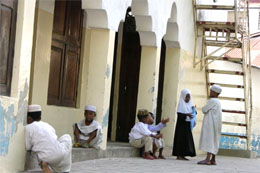
Stone Town Children |
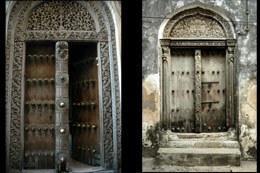
Stone town Doorways |
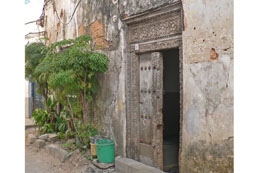
Stone Town Building |
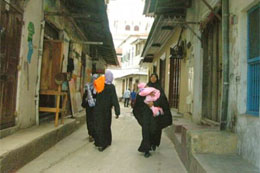
Muslim Women |
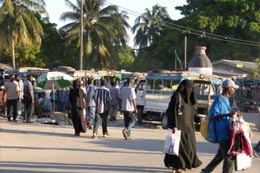
Stone town Street |
We found our waiting taxi at the main park and then headed “home” to Pongwe for beer and another delicious dinner. Phil joined us with lots of laughs. He’s bonded with our group. He’ll be opening up a small hotel in Paris and is trying desperately to build his future clientele. He and Val do a wonderful job.
10.16 .05 – Last Day
After an early breakfast, we walked way out into the ocean. Unfortunately, Bill stepped on something that stung him – have no idea what it was. Poor Bill had to deal with the pain (and a visit to doctor) for a couple months after we returned to the States. No more barefoot on wild, exotic beaches.
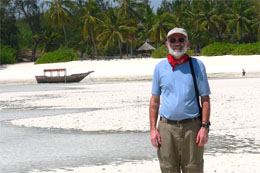
Bill on Beach |
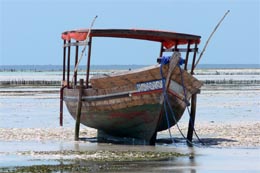
Boat at low tide |
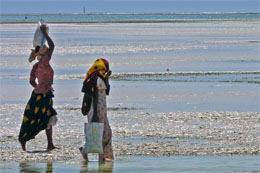
Local women on beach |
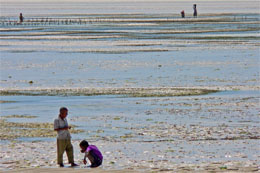
Kids on beach, low tide |
We finished packing, ate a snack and said goodbye to our Zanzibar hosts. All 12 of us (plus our baggage) fit into one van and headed across the island to the airport.
On our 15-minute flight to Dar es Salaam, Kim had to sit up in the cockpit. Because her seat had a non-working seat belt, she got to ride with the pilot. Africa is crazy – I’ll miss it.
At Dar es salaam, we had a 5-hour wait so we ate in shifts, some watching the luggage while the others went to the Pink Flamingo Cafeteria. The cold pizza was gut wrenching.
At 11 pm, we caught our flight to Amsterdam. I missed dinner on the plane and choose sleep instead. About 6:30 am, we arrived in Amsterdam and hung out until 11 am for our flight to Detroit. Amsterdam has the best airport ever – even has a museum for weary travelers.
We arrived in Detroit about noon and then took off for San Diego at 3:45 pm –
the last leg – almost home -- Can’t wait to see my little ZiZi.
6 months later -- Back at Home in San Diego
Although the surf has long since washed away our footprints, we have beautiful memories and amazing sea shells we gathered on the beaches of a far-away place -- Zanzibar.











